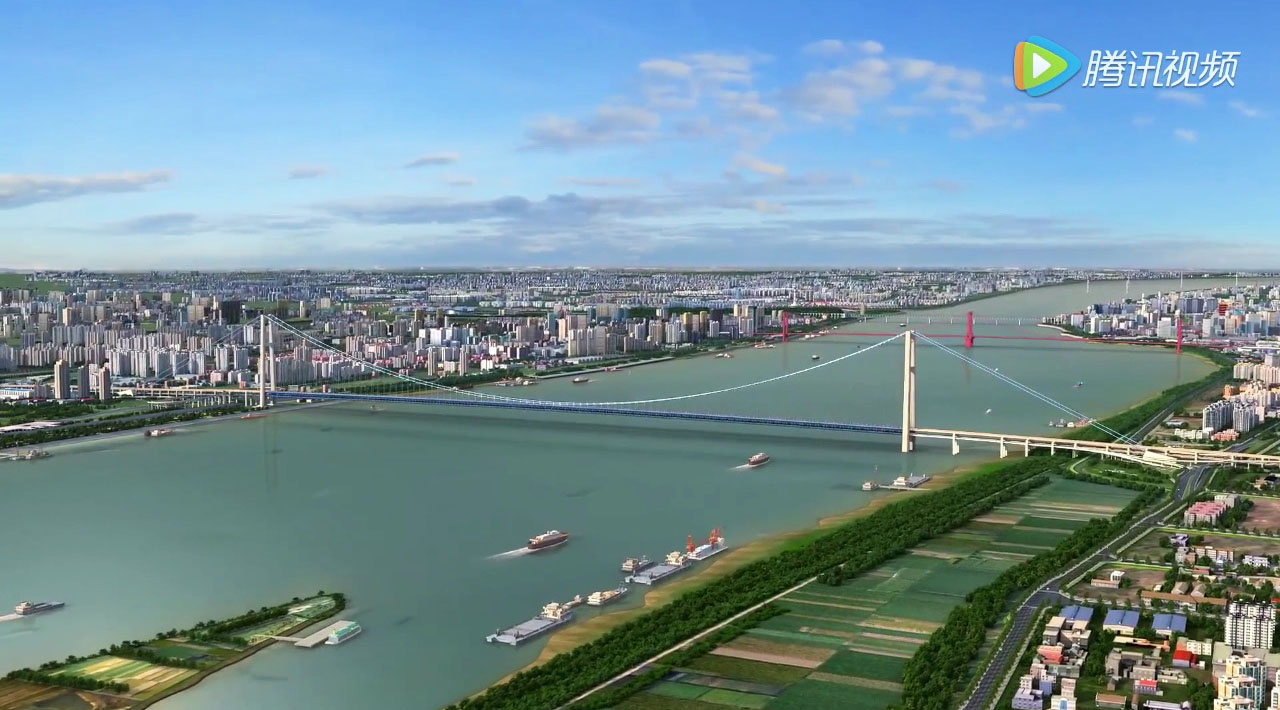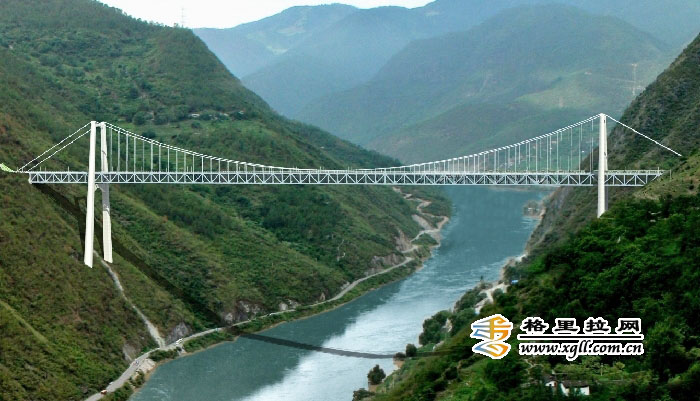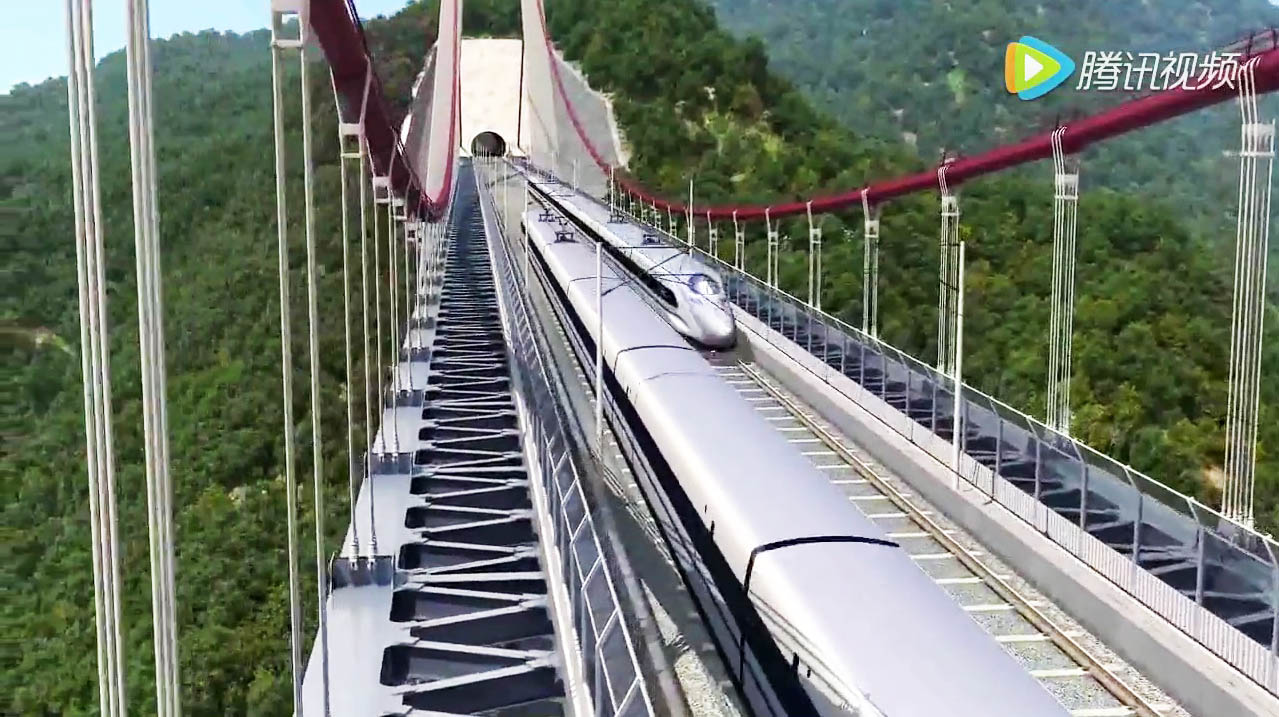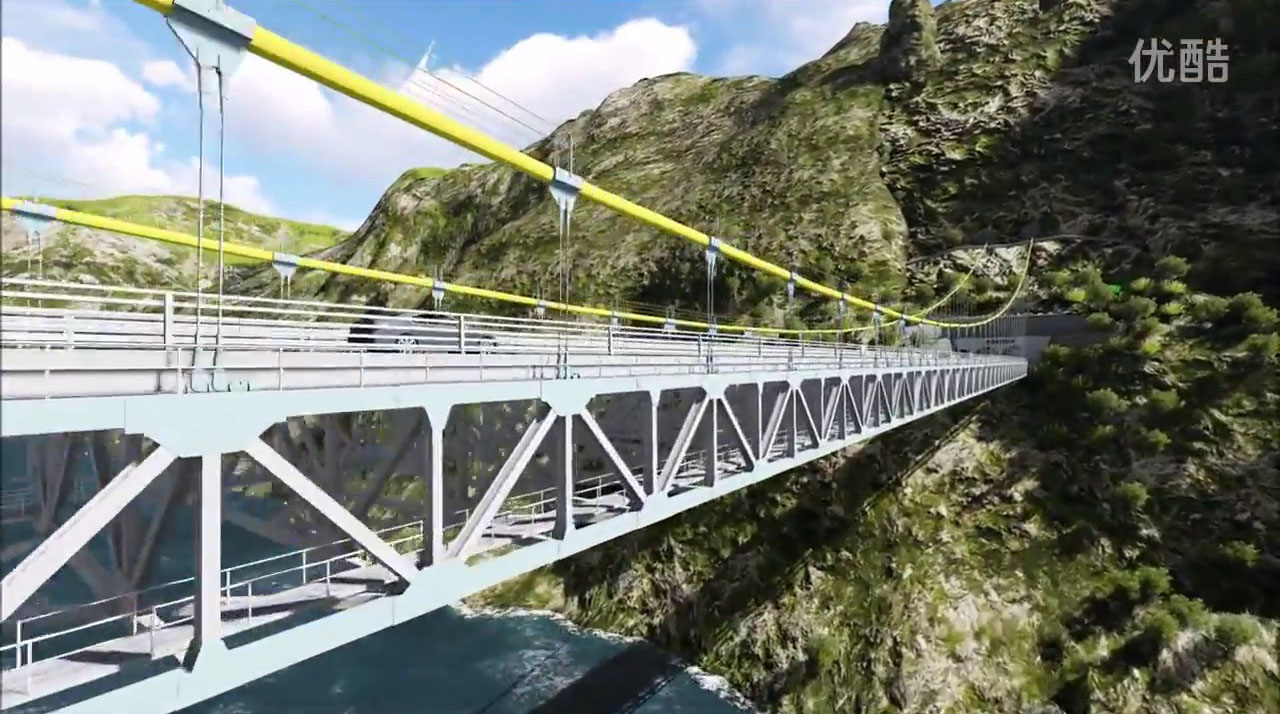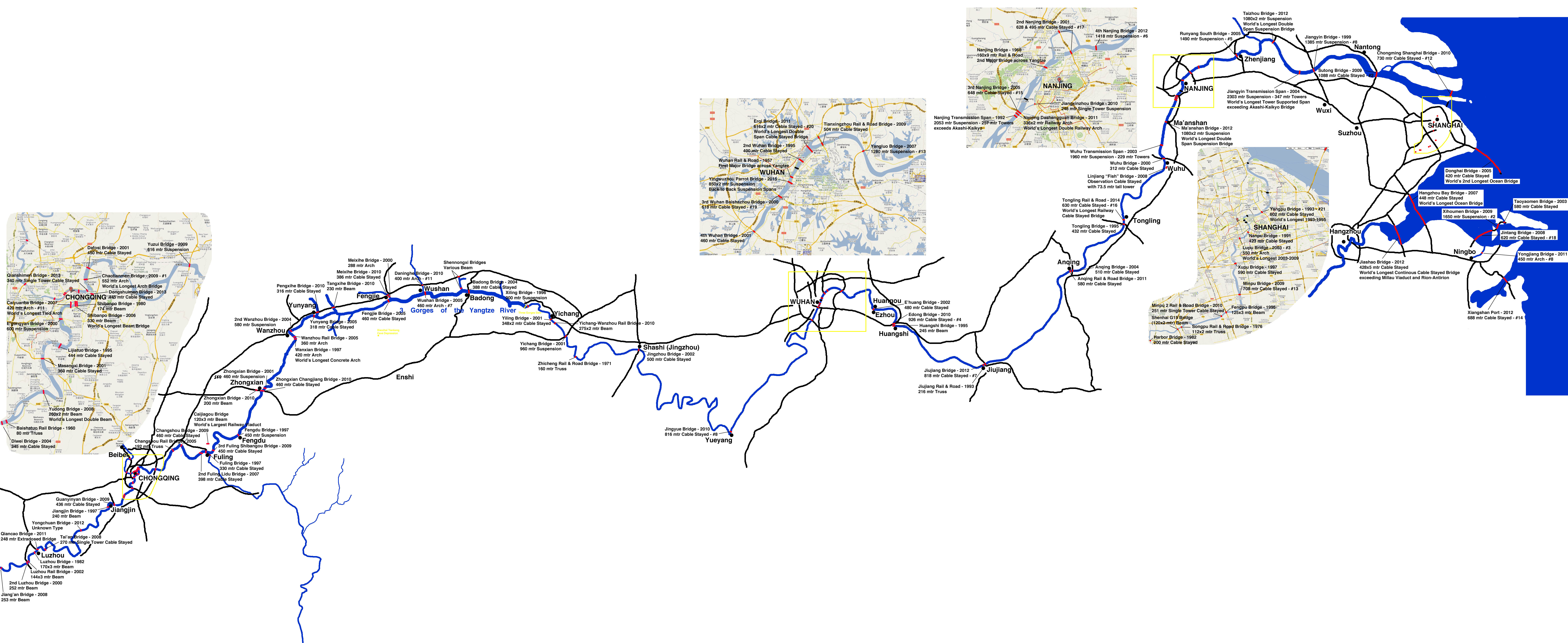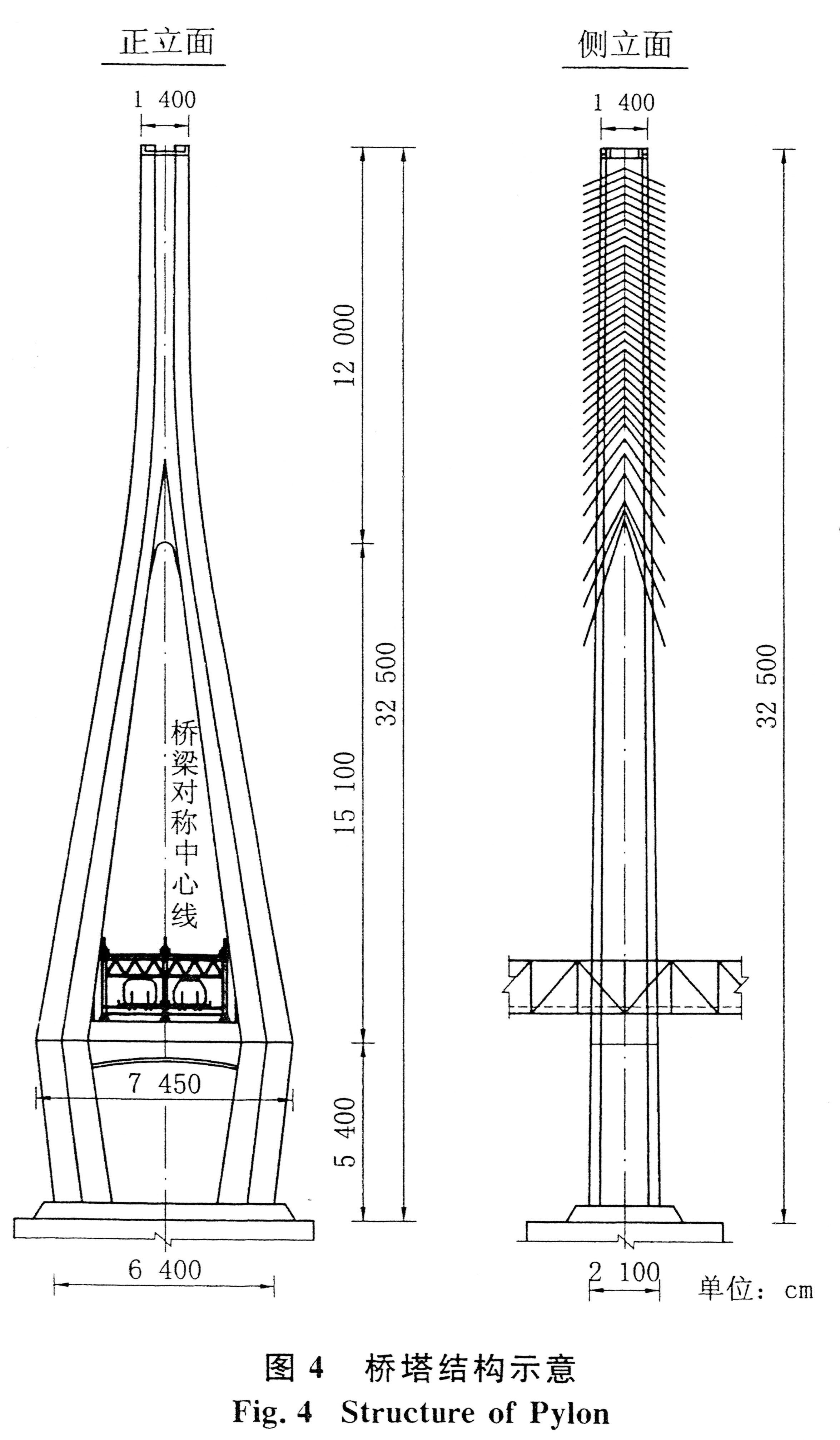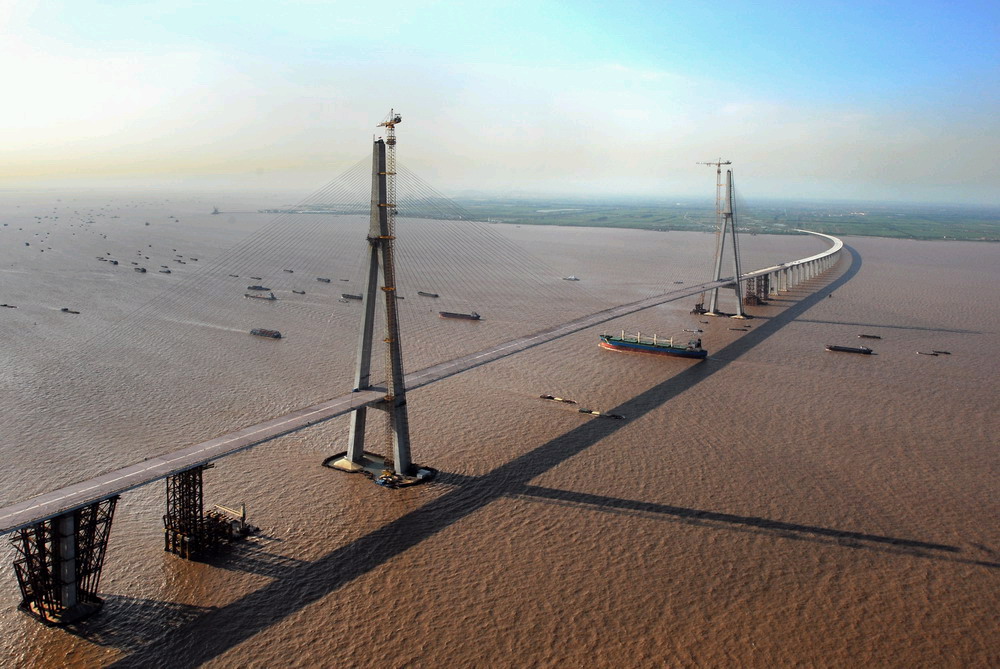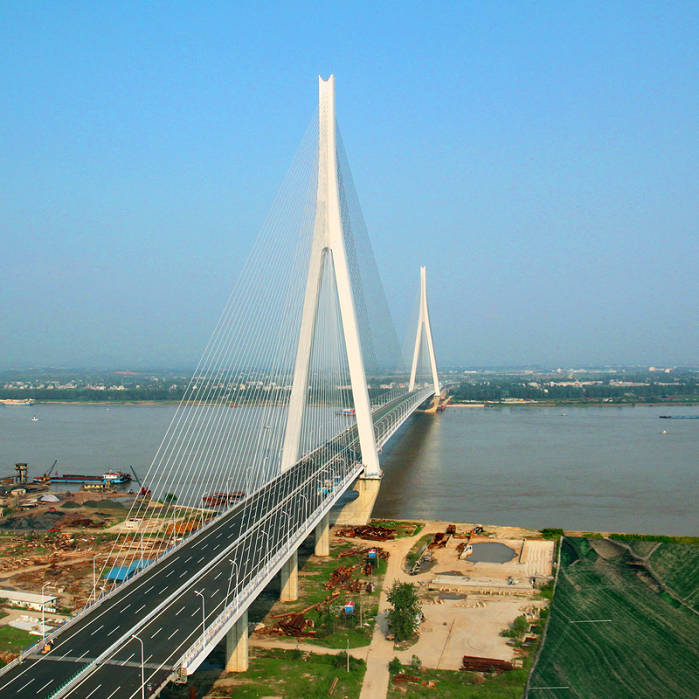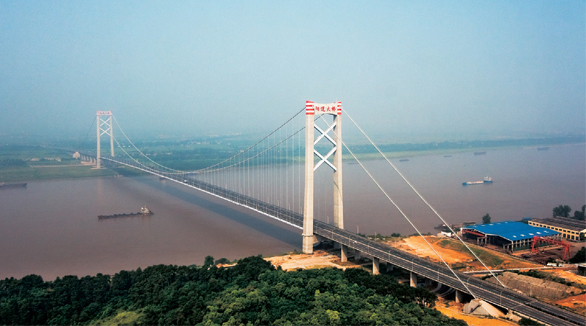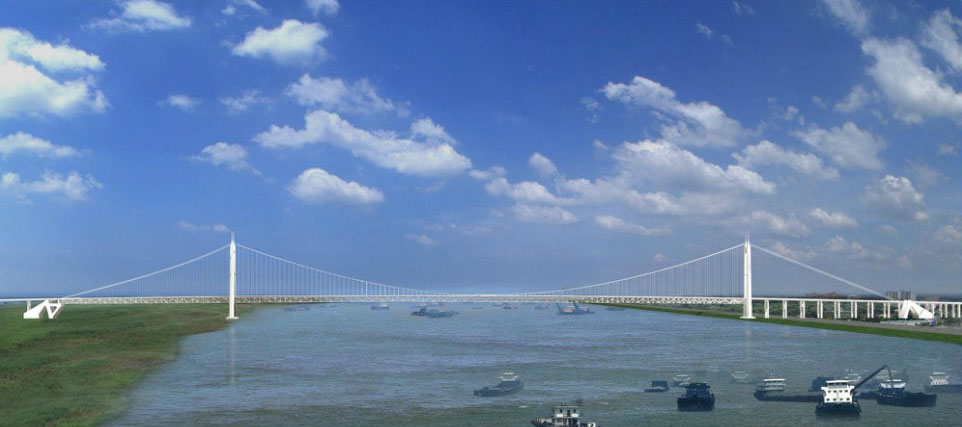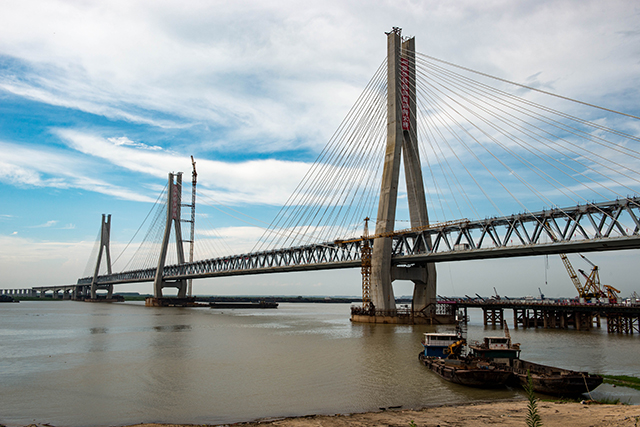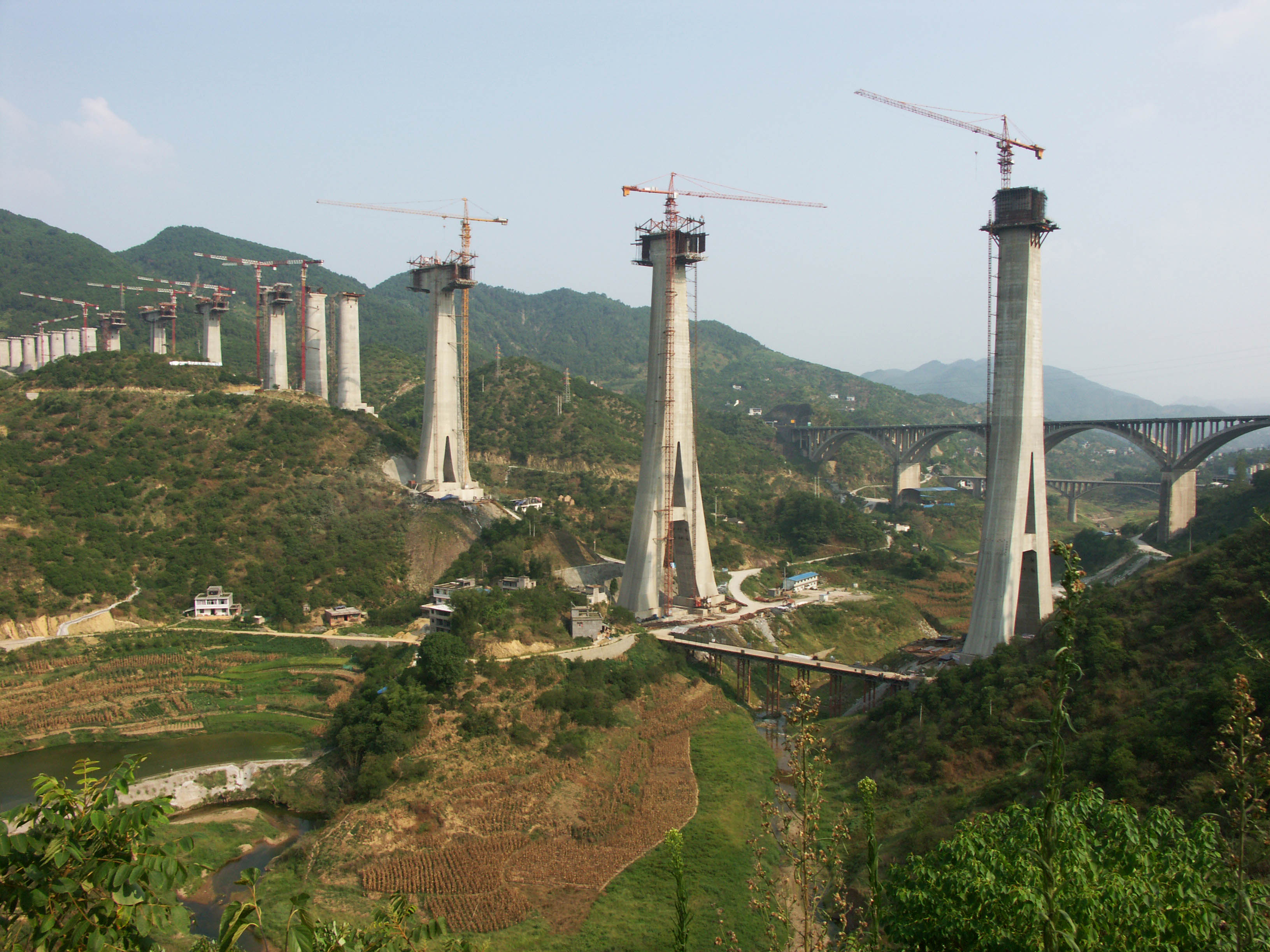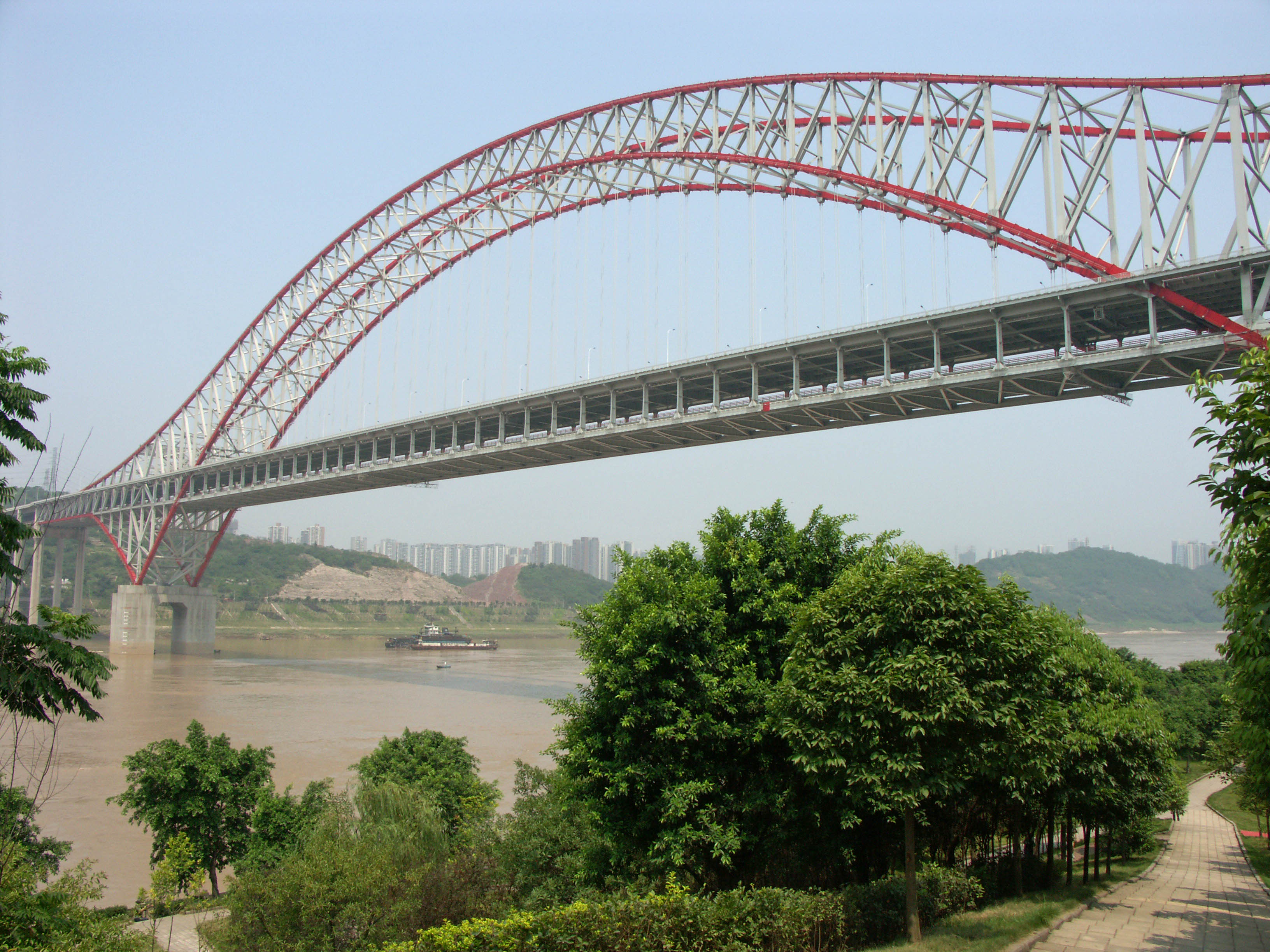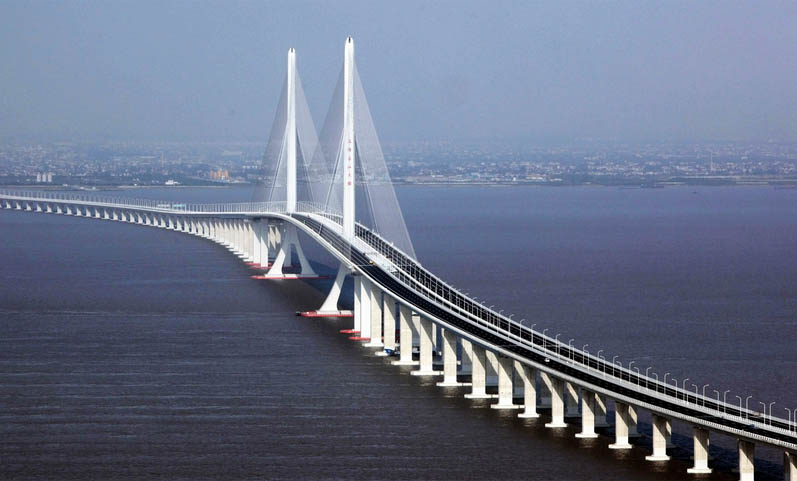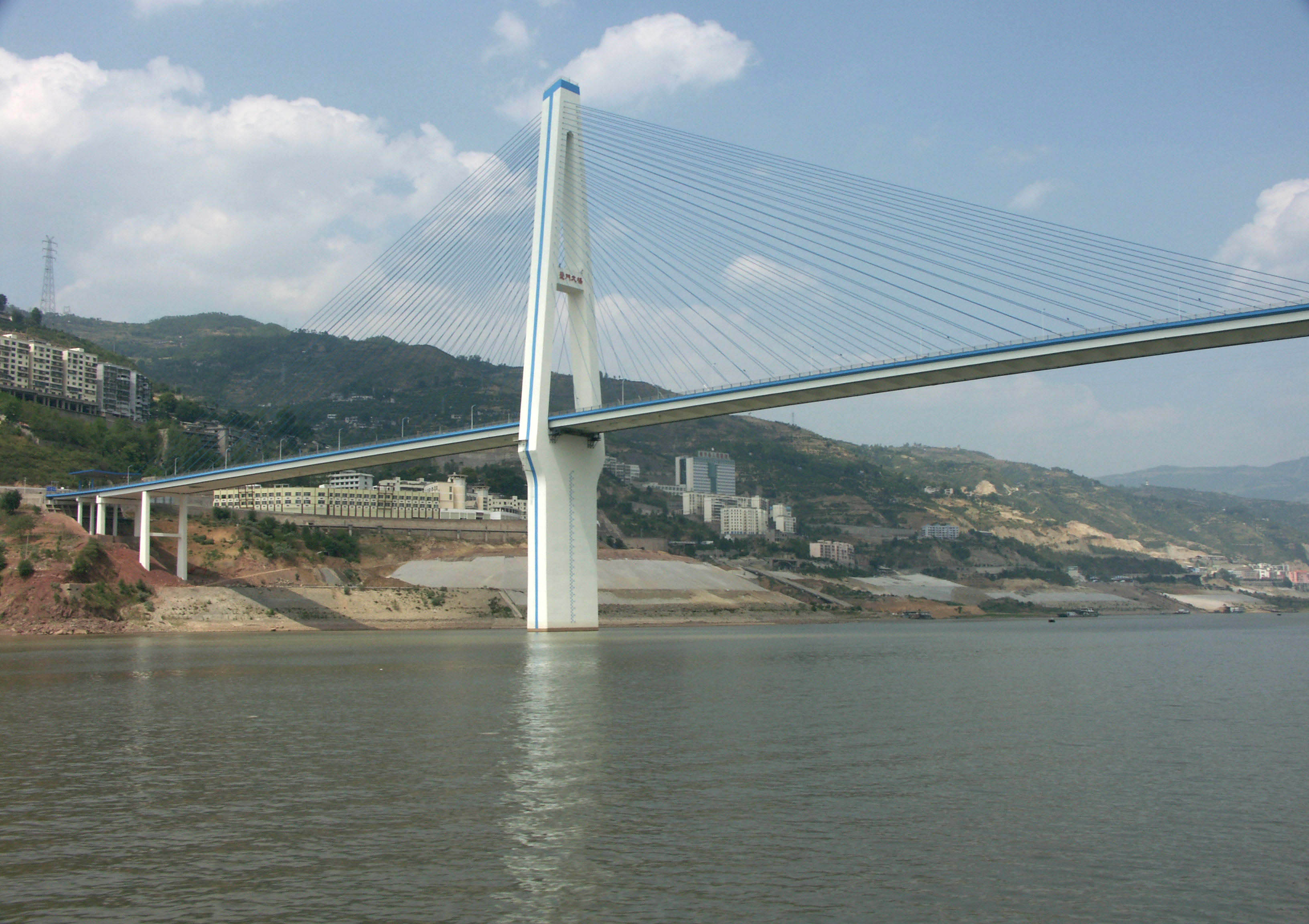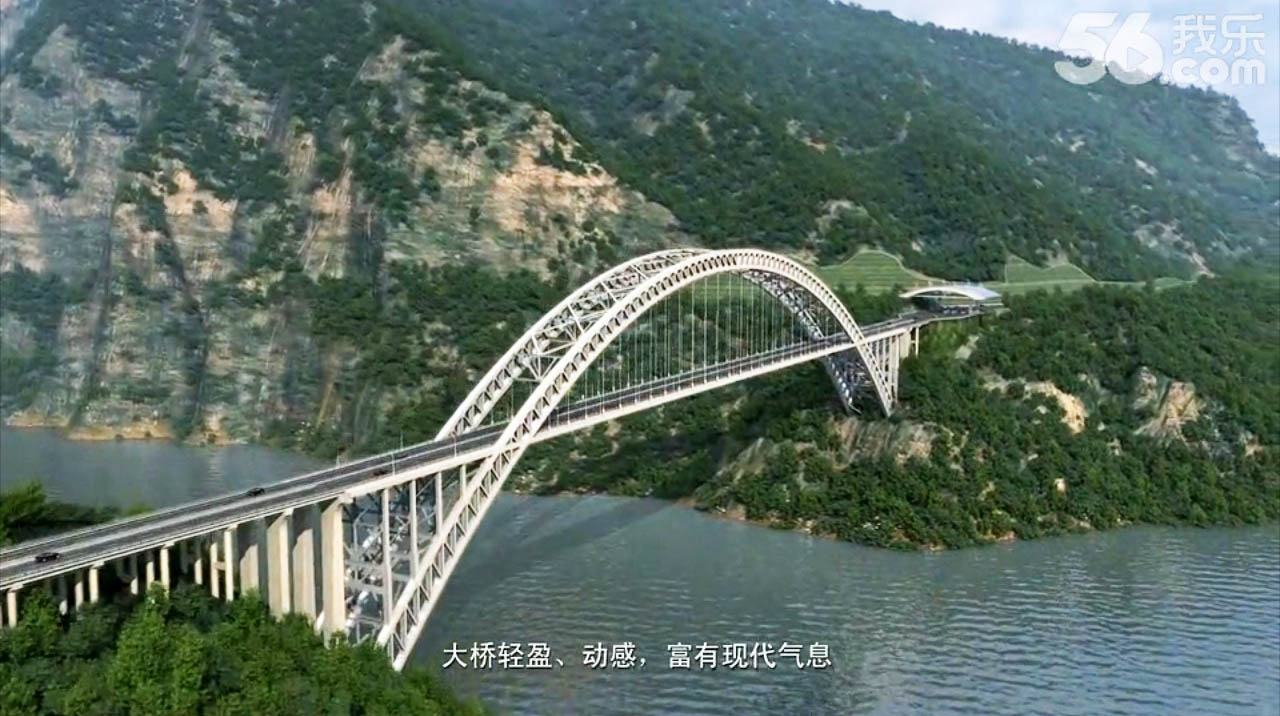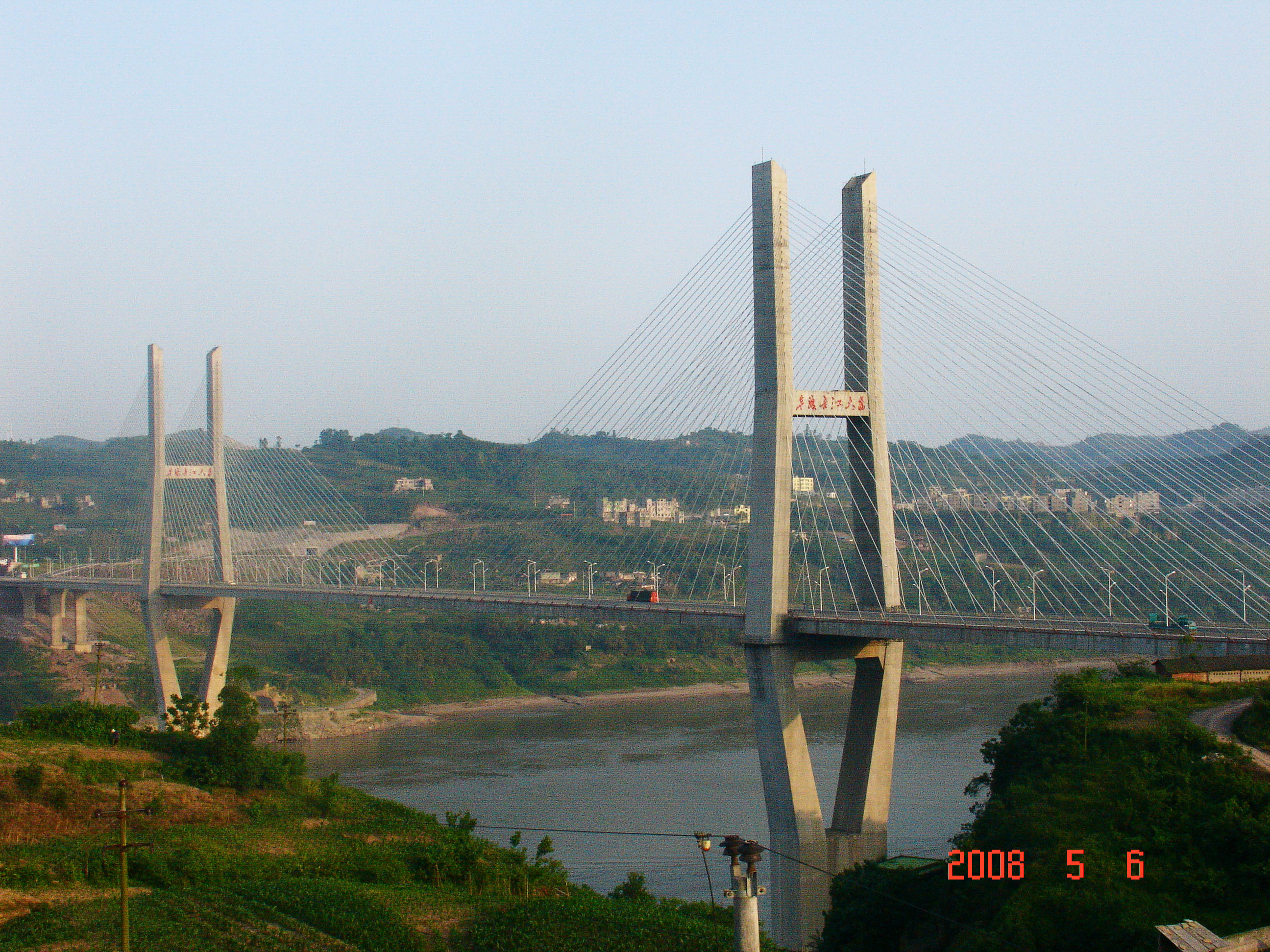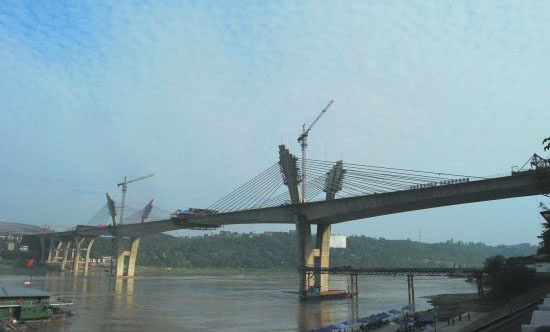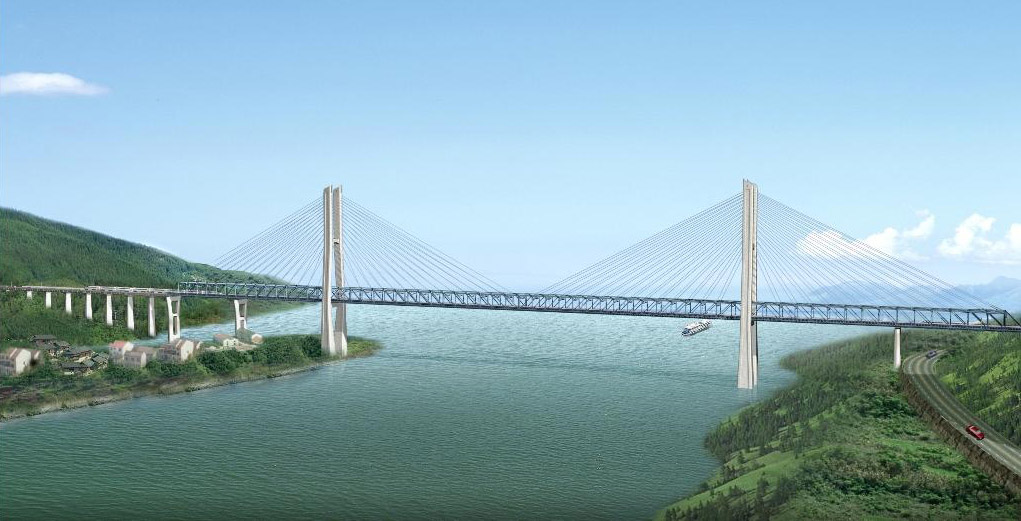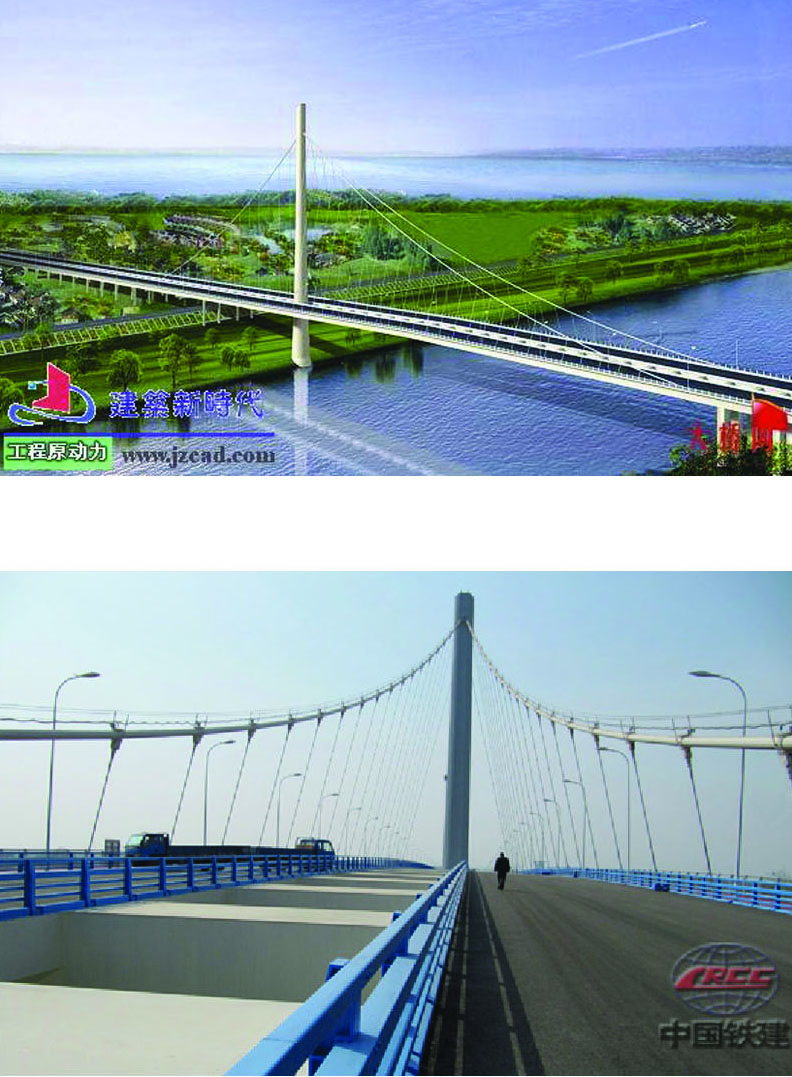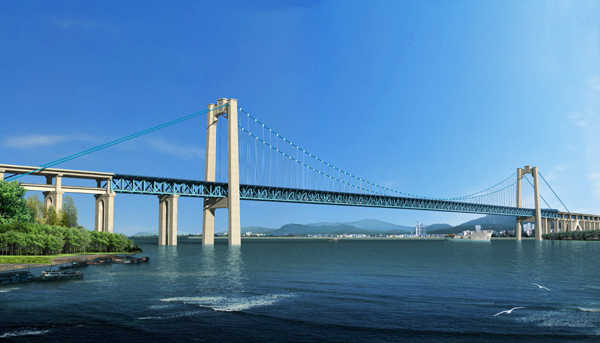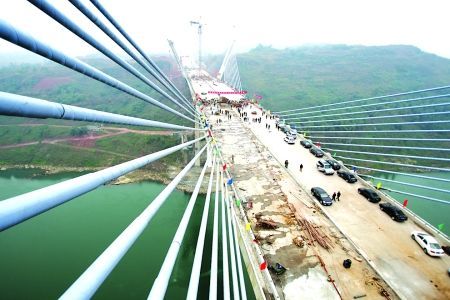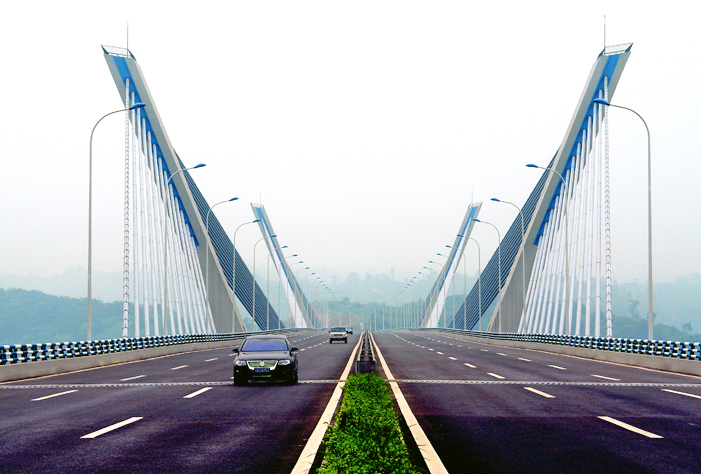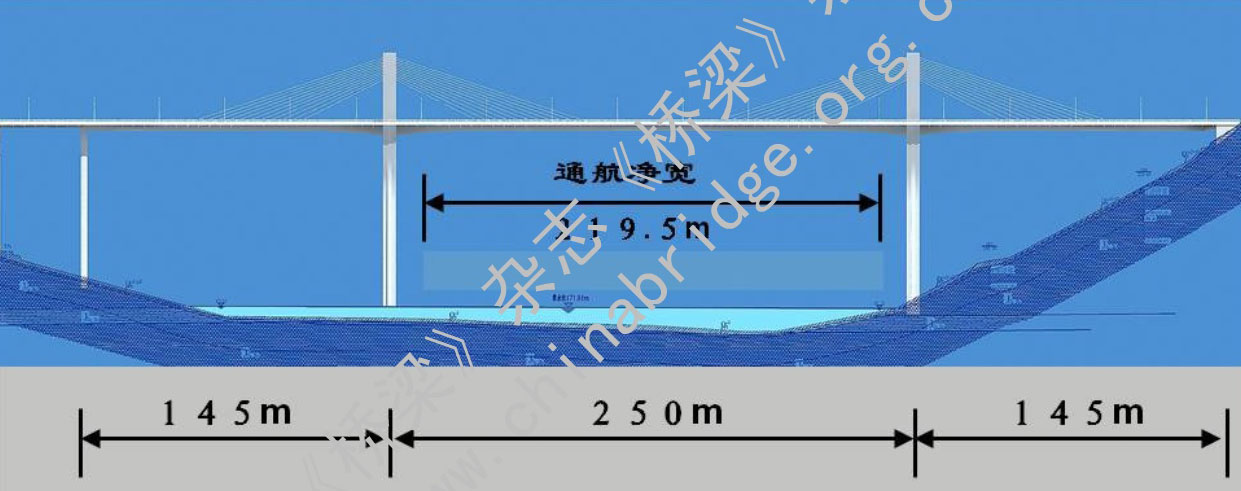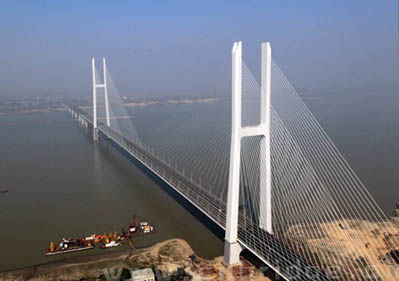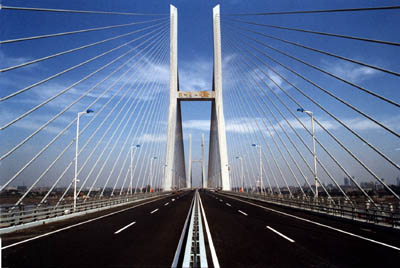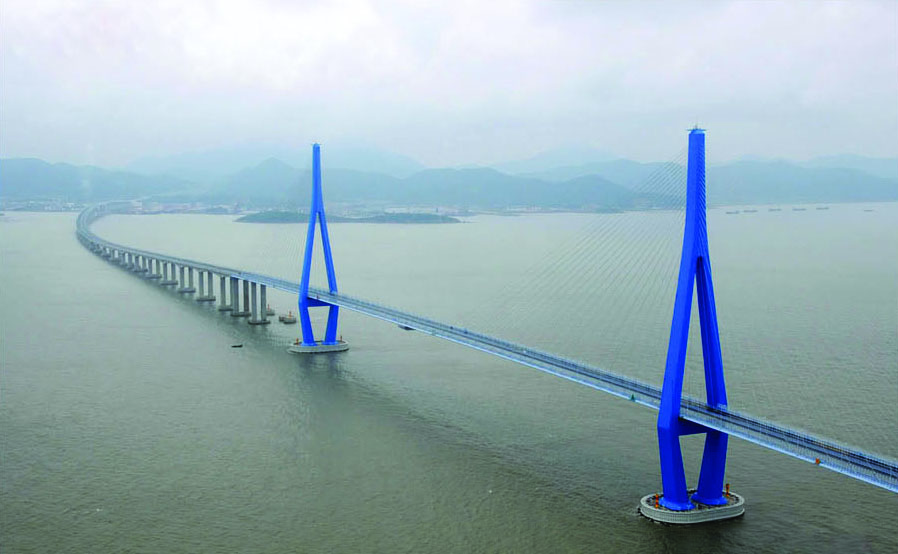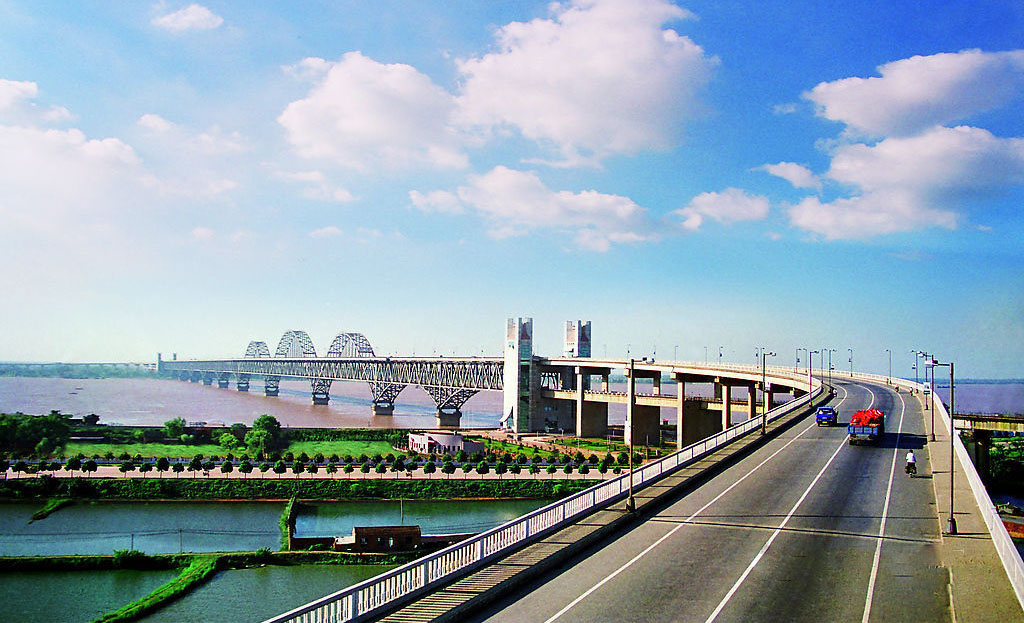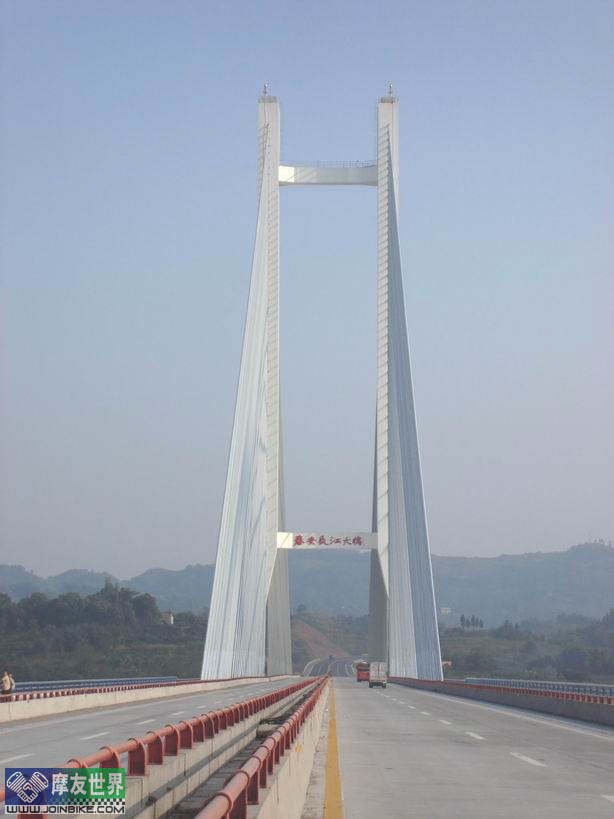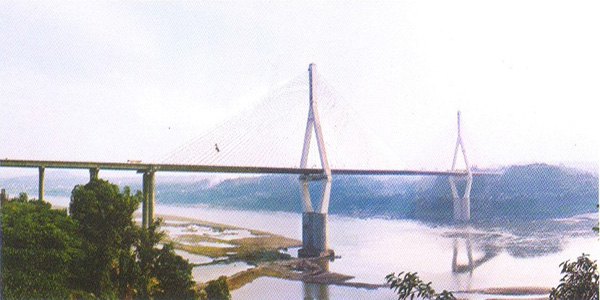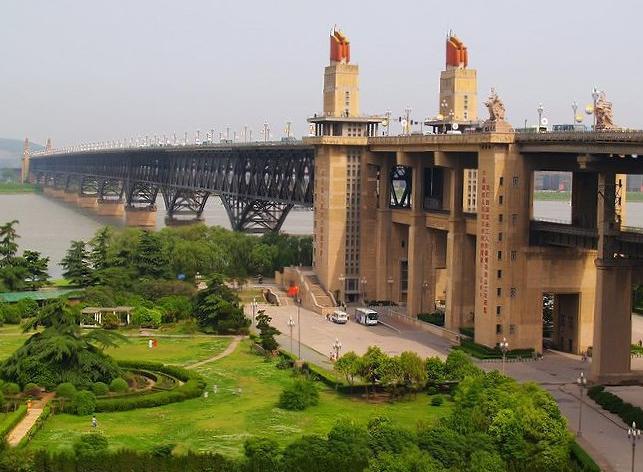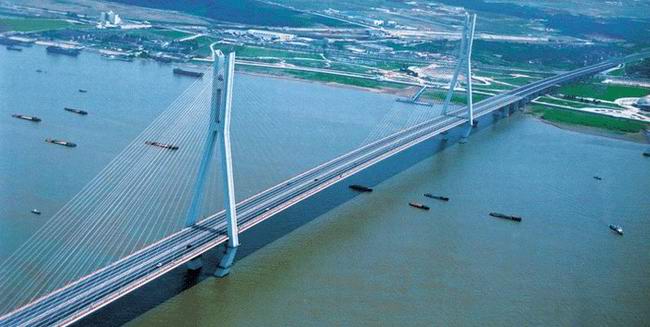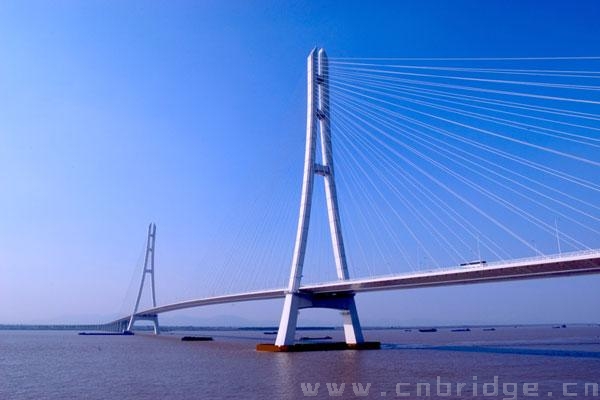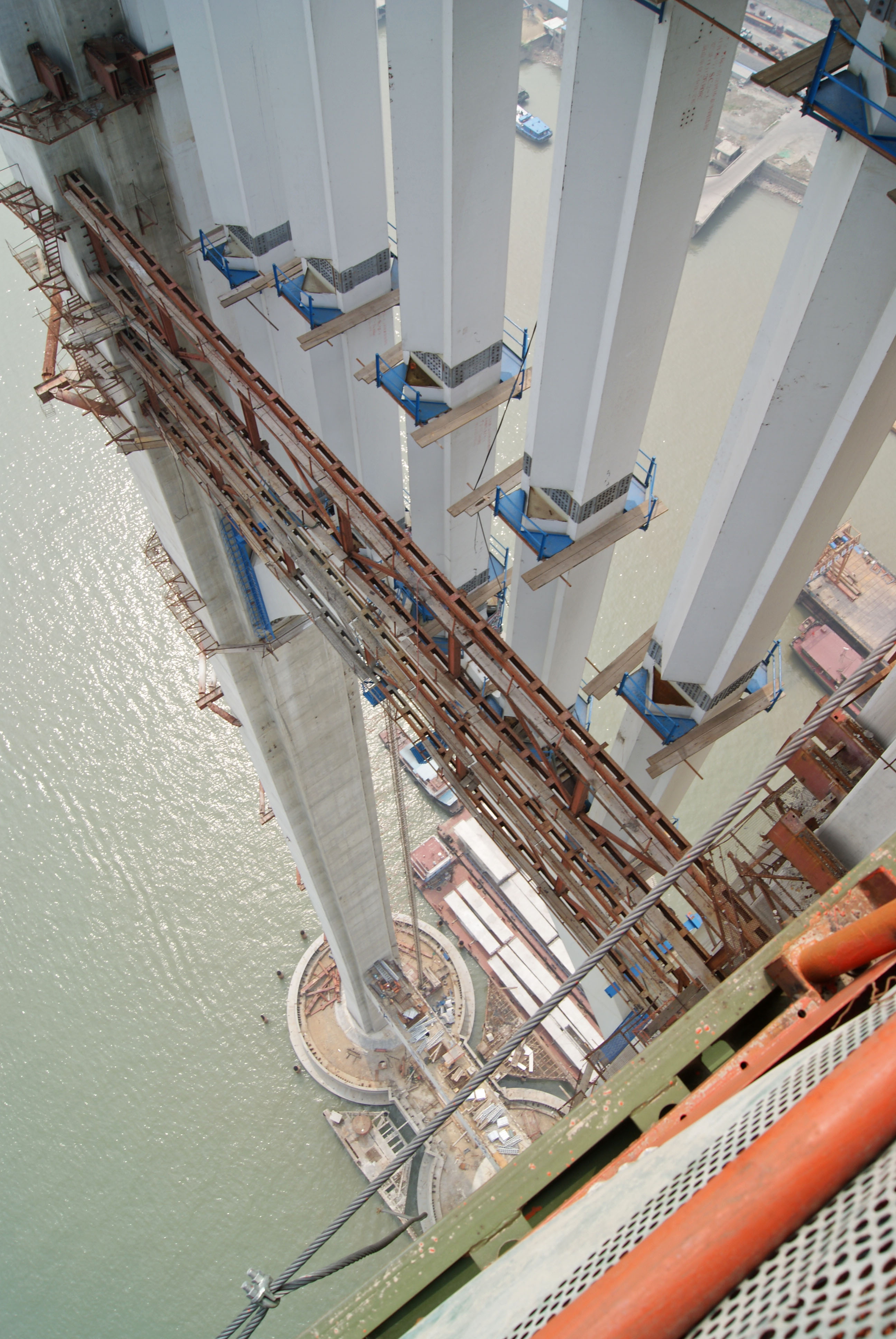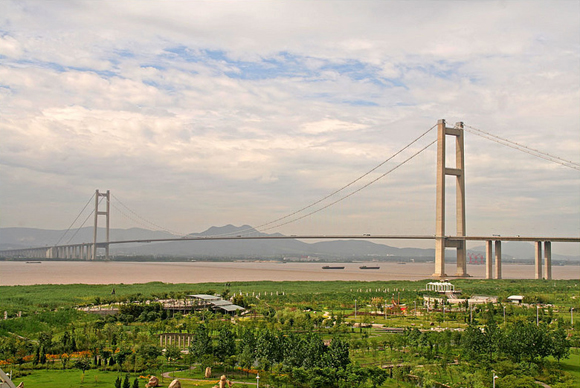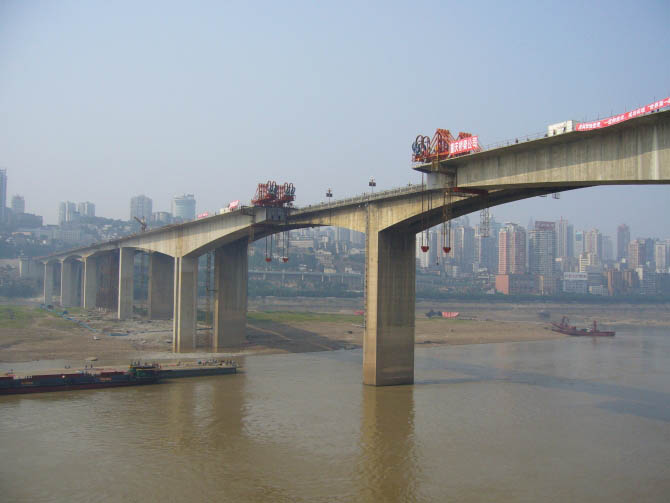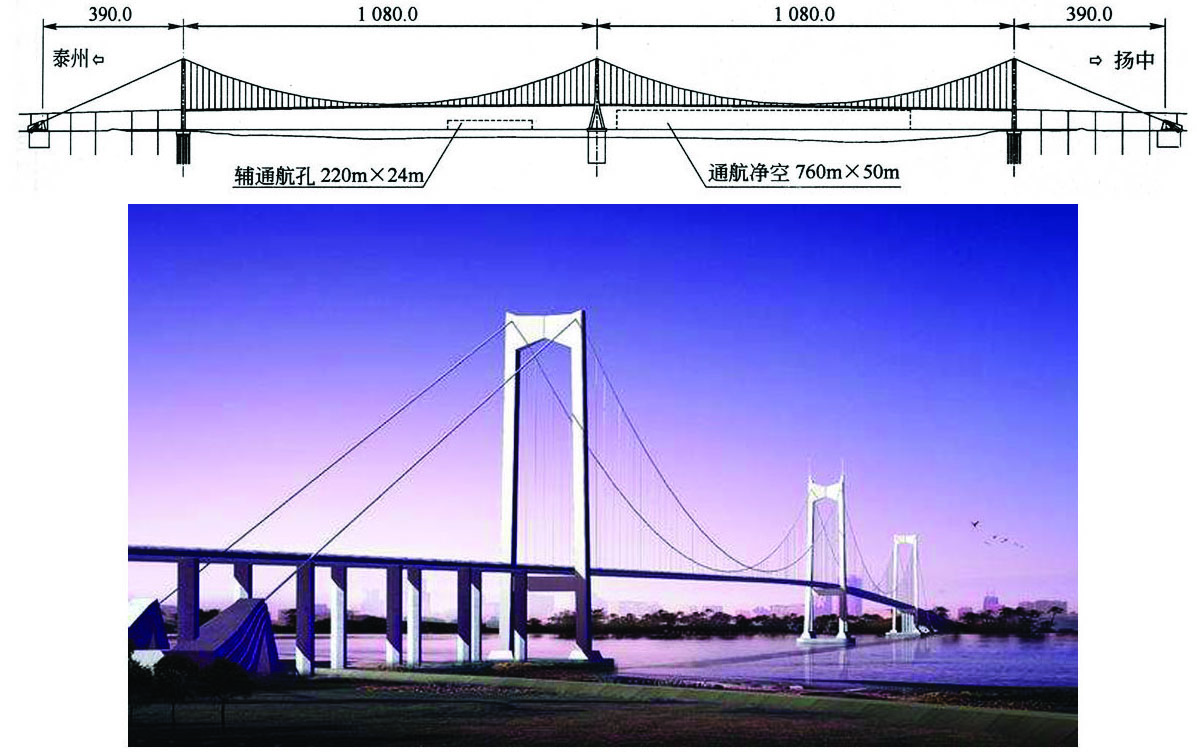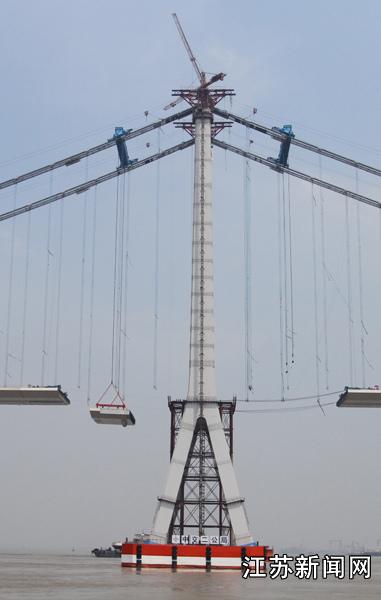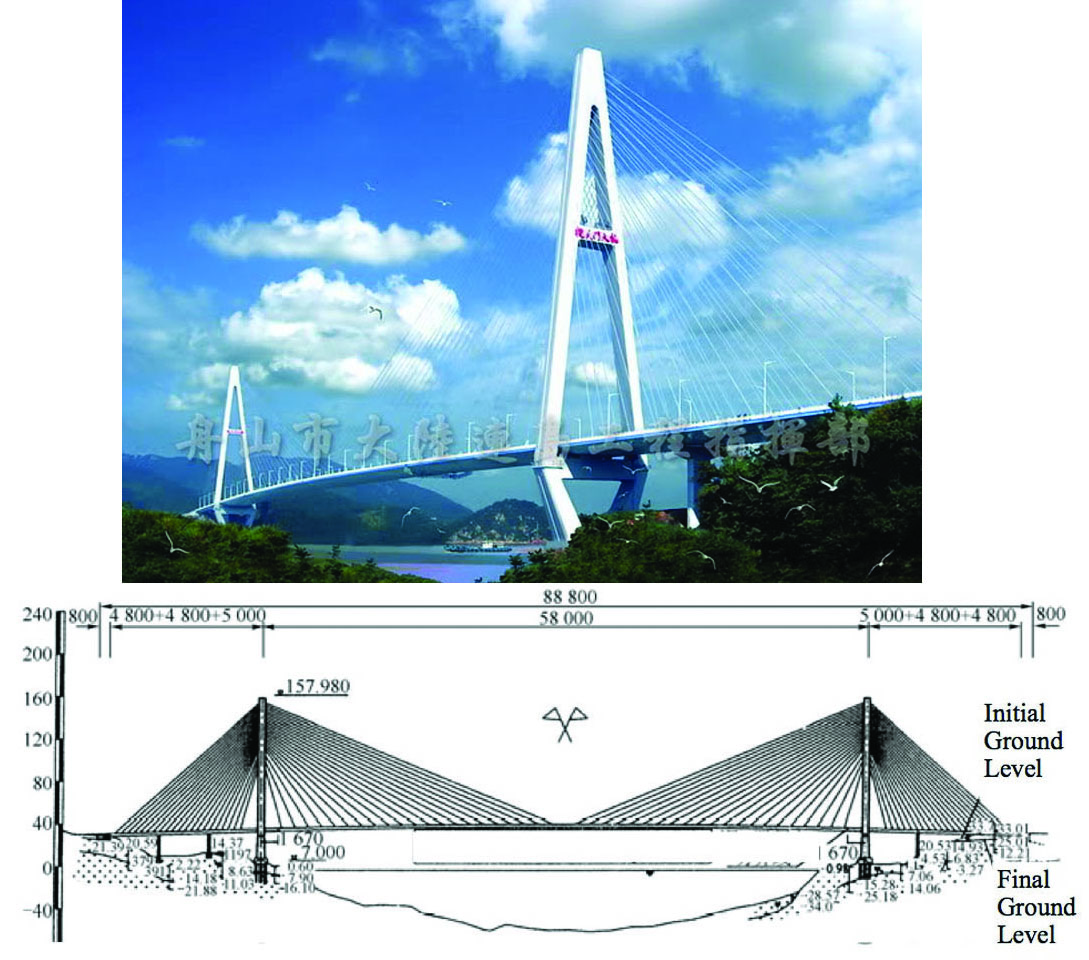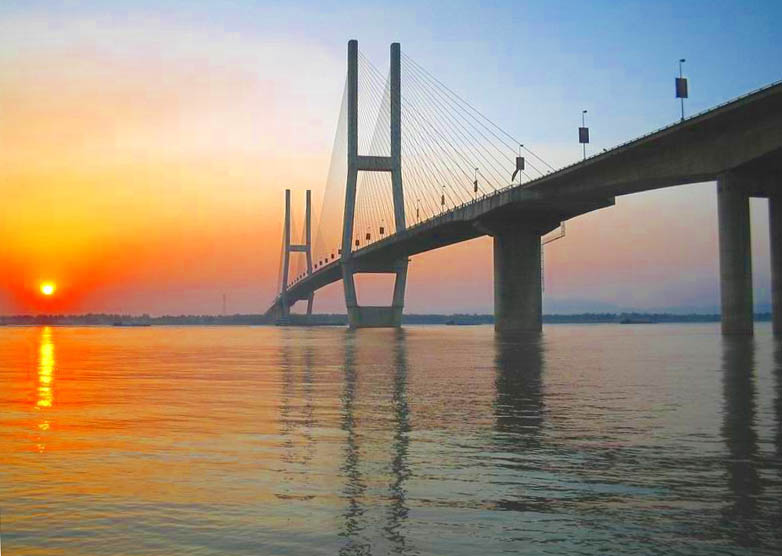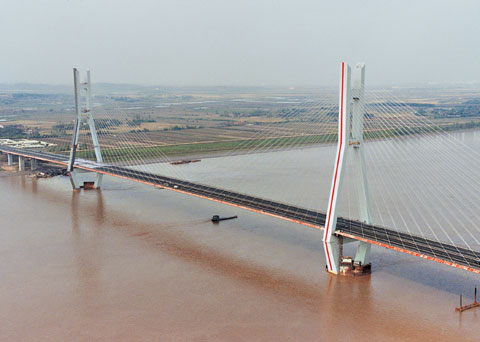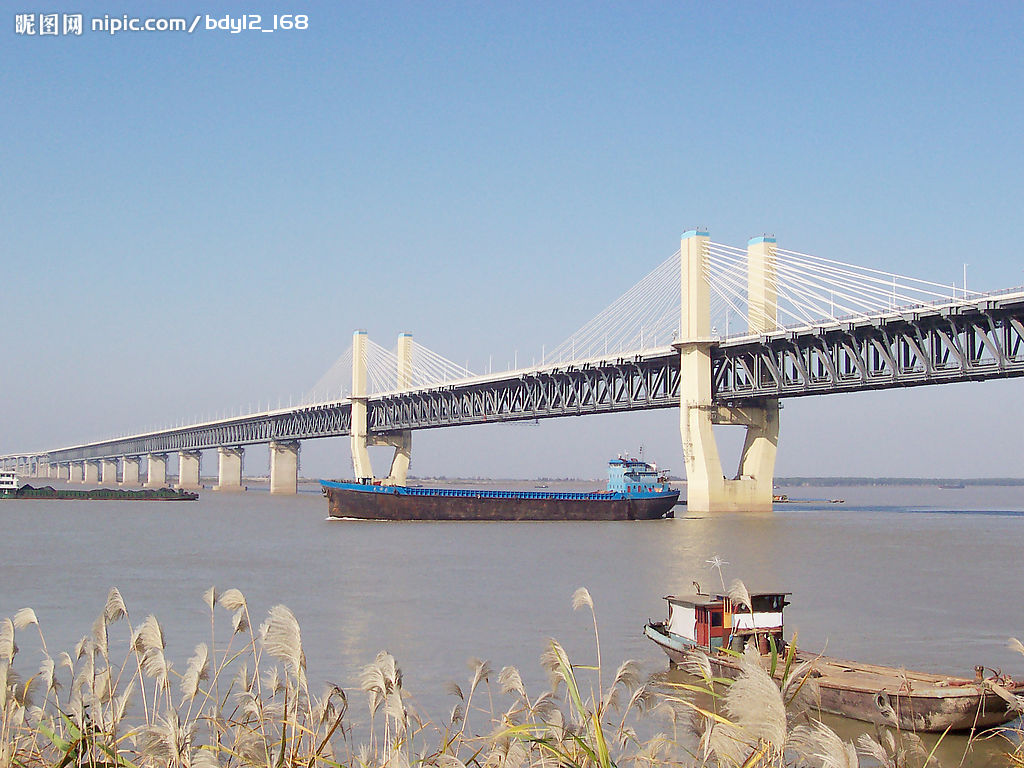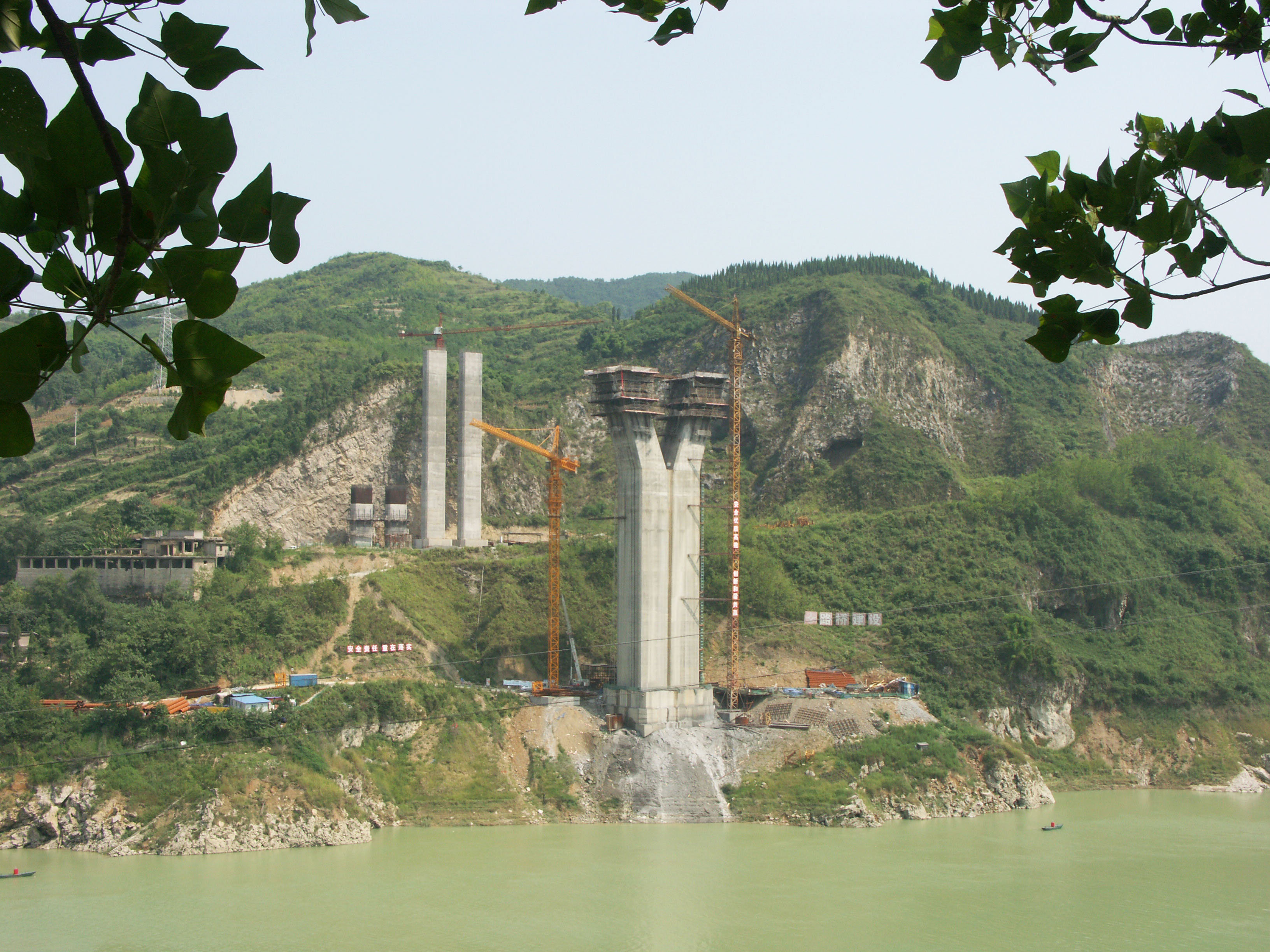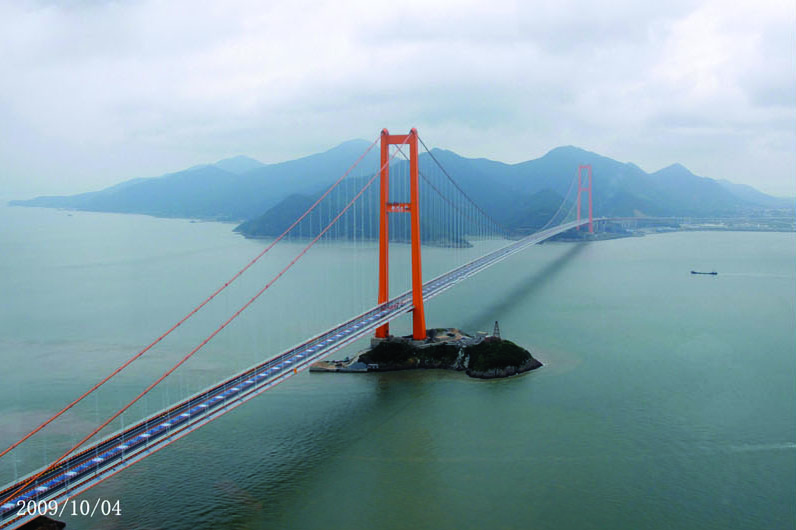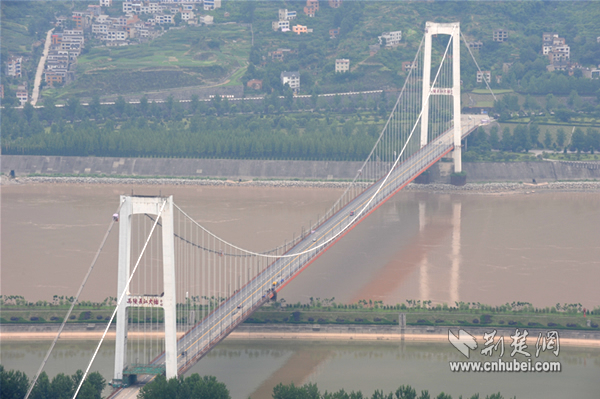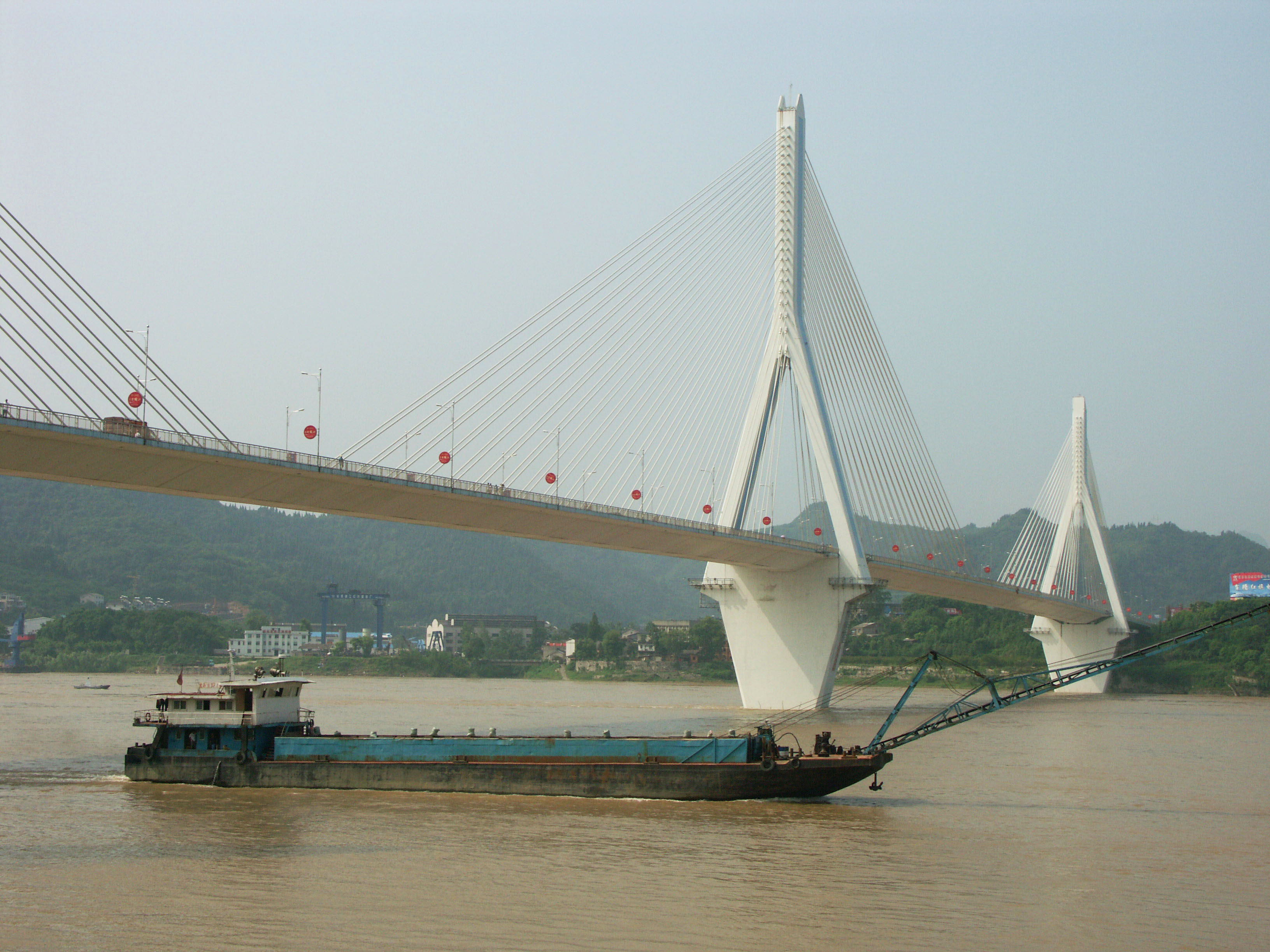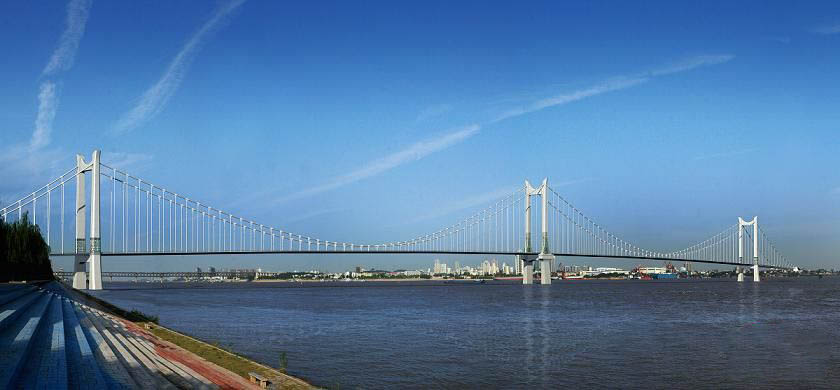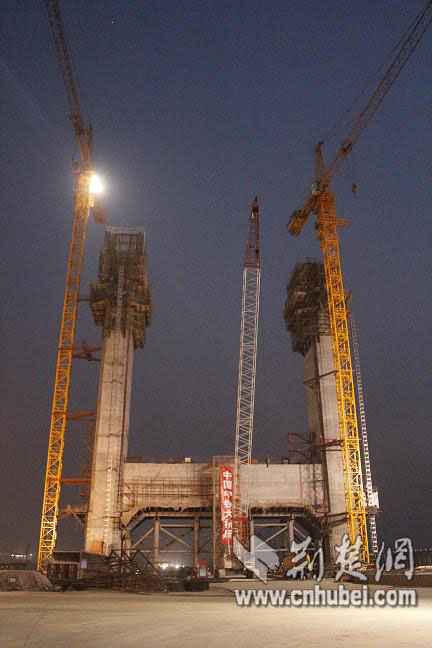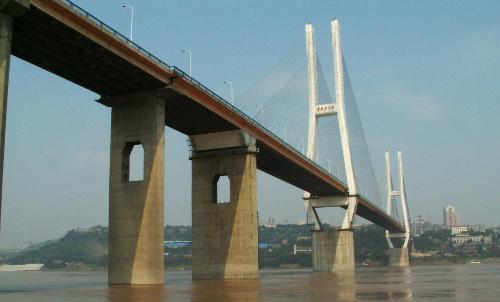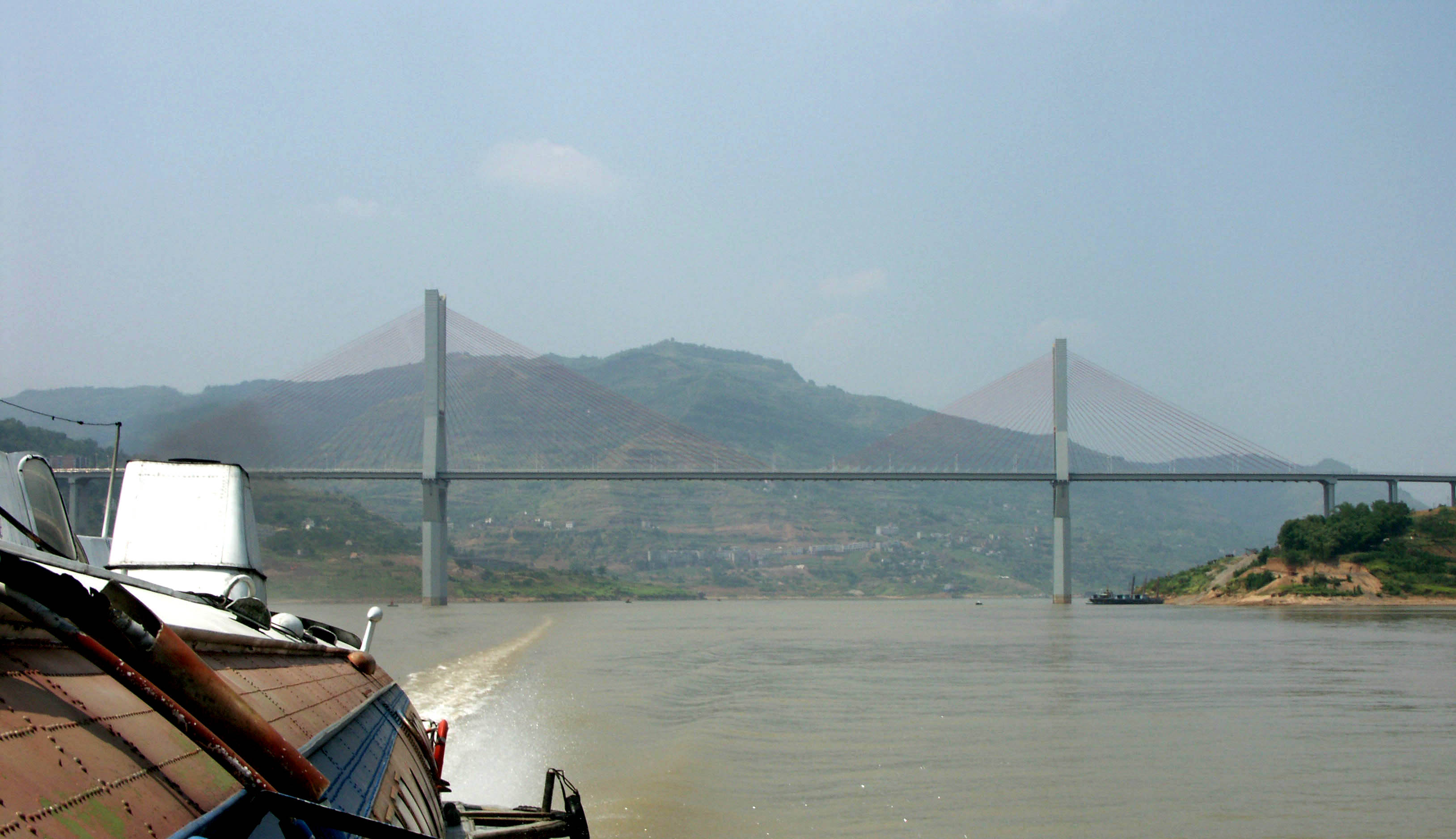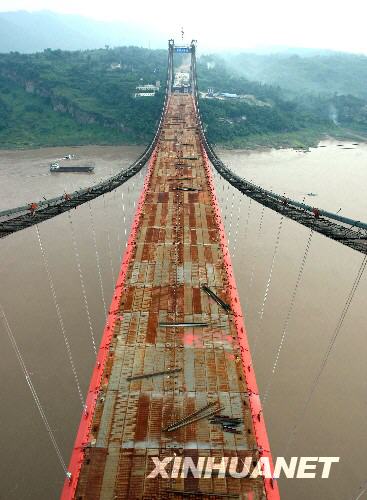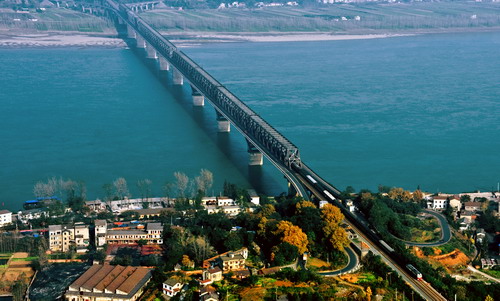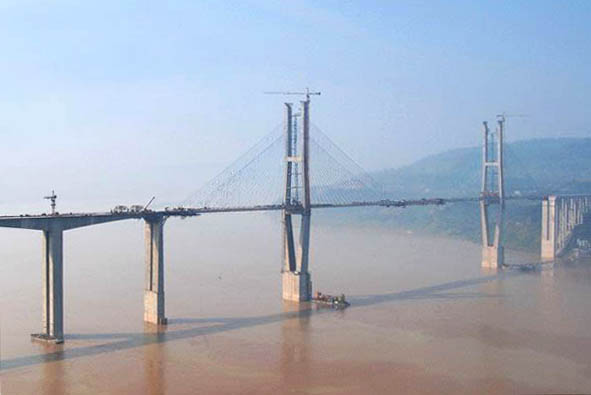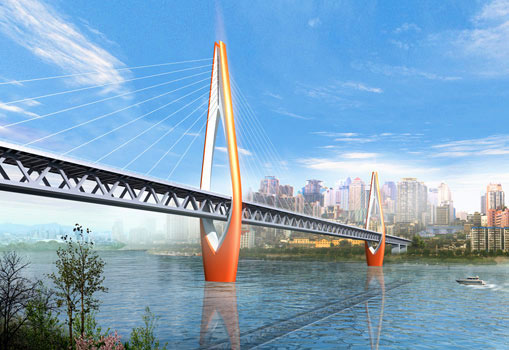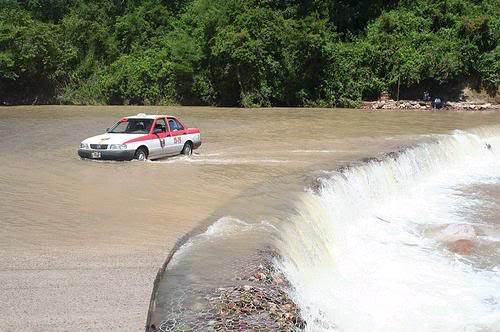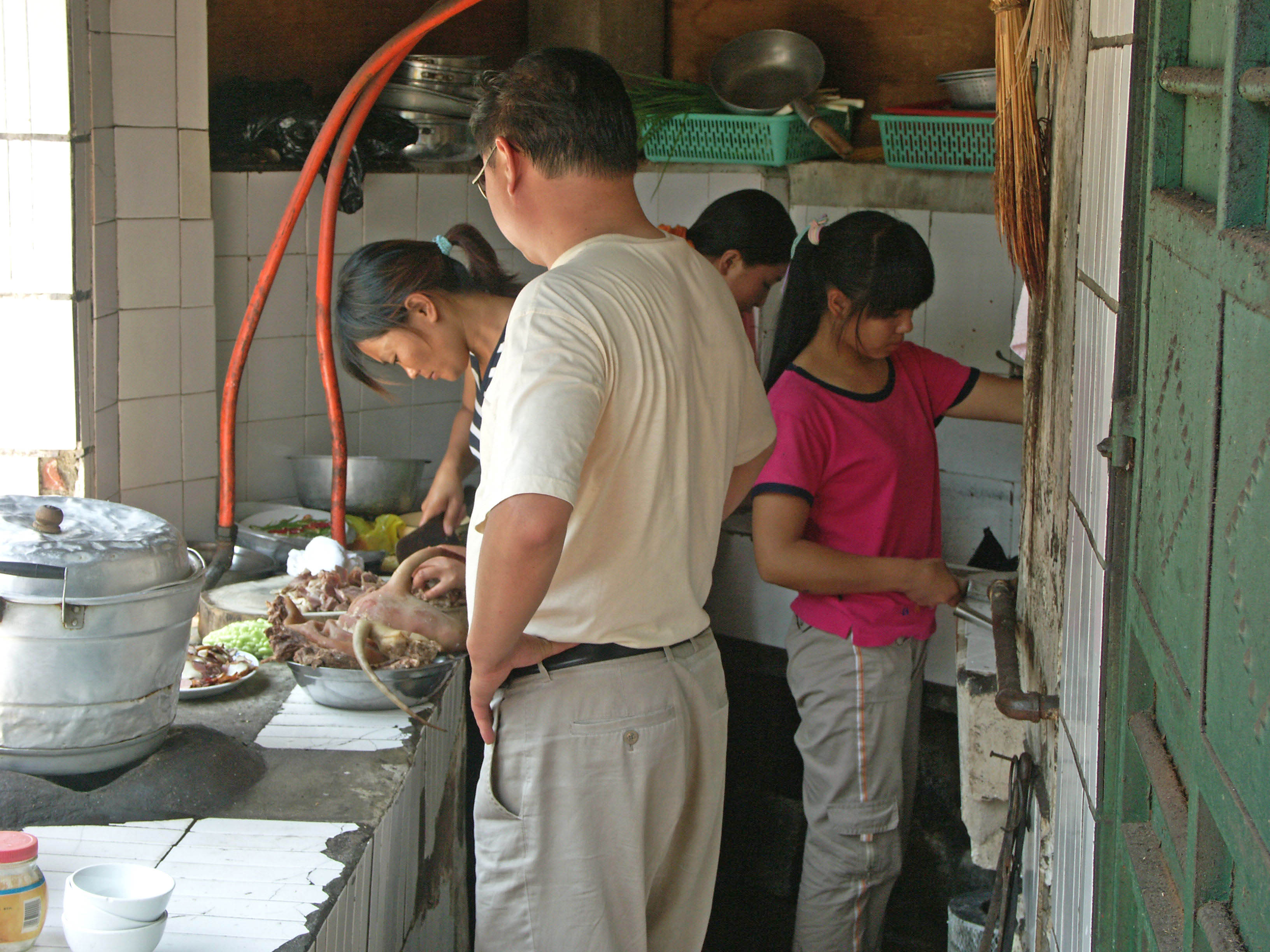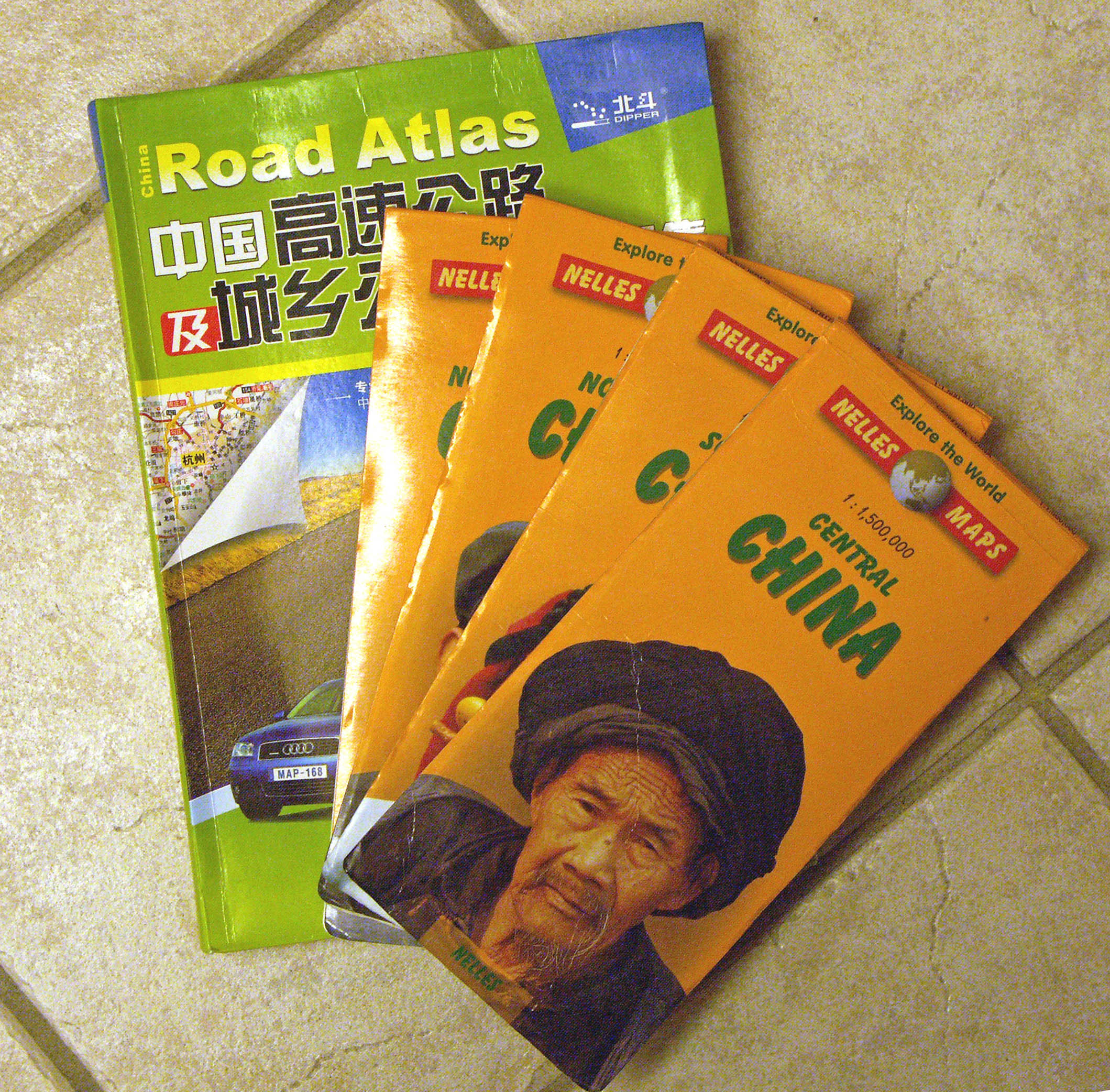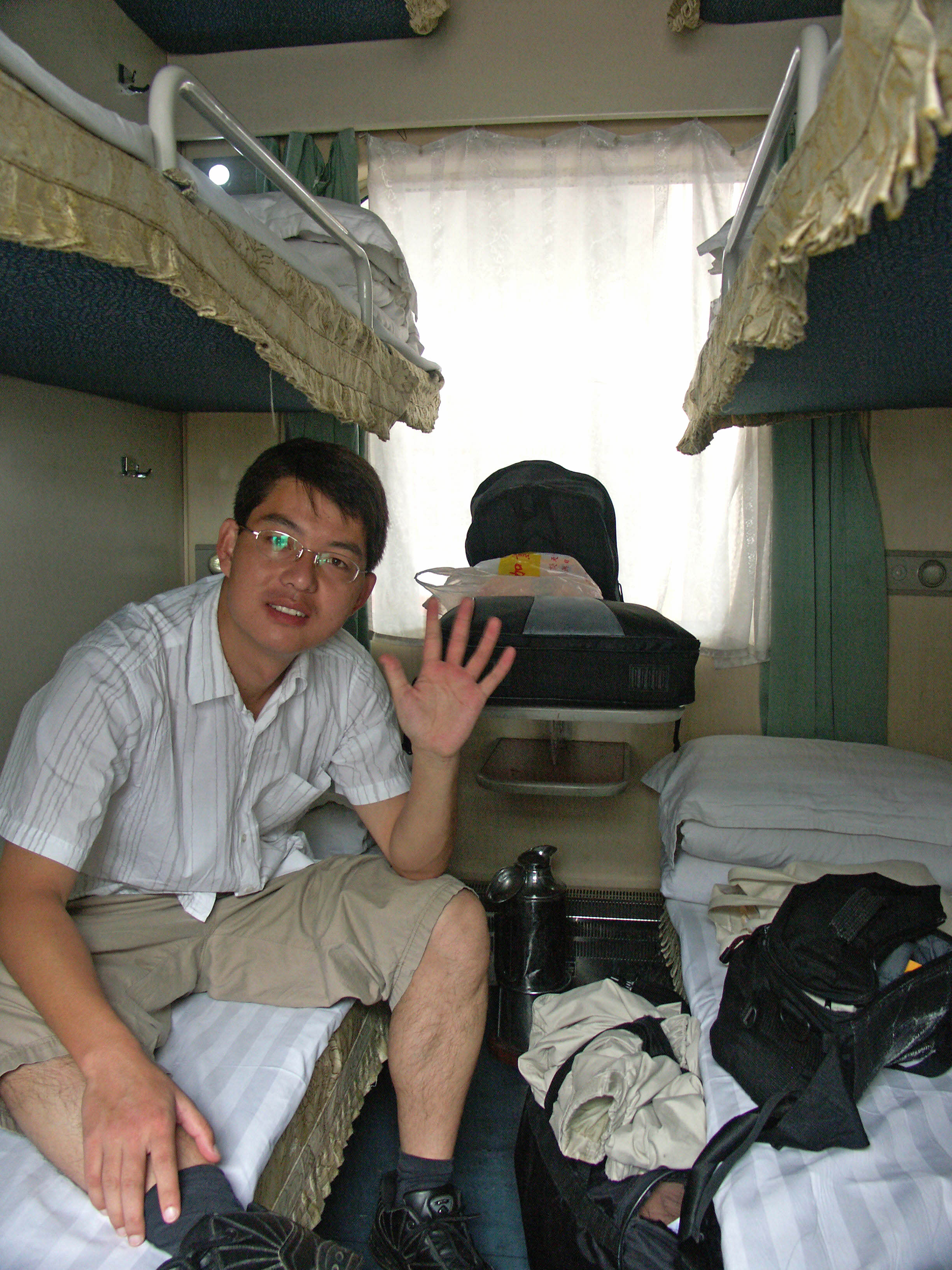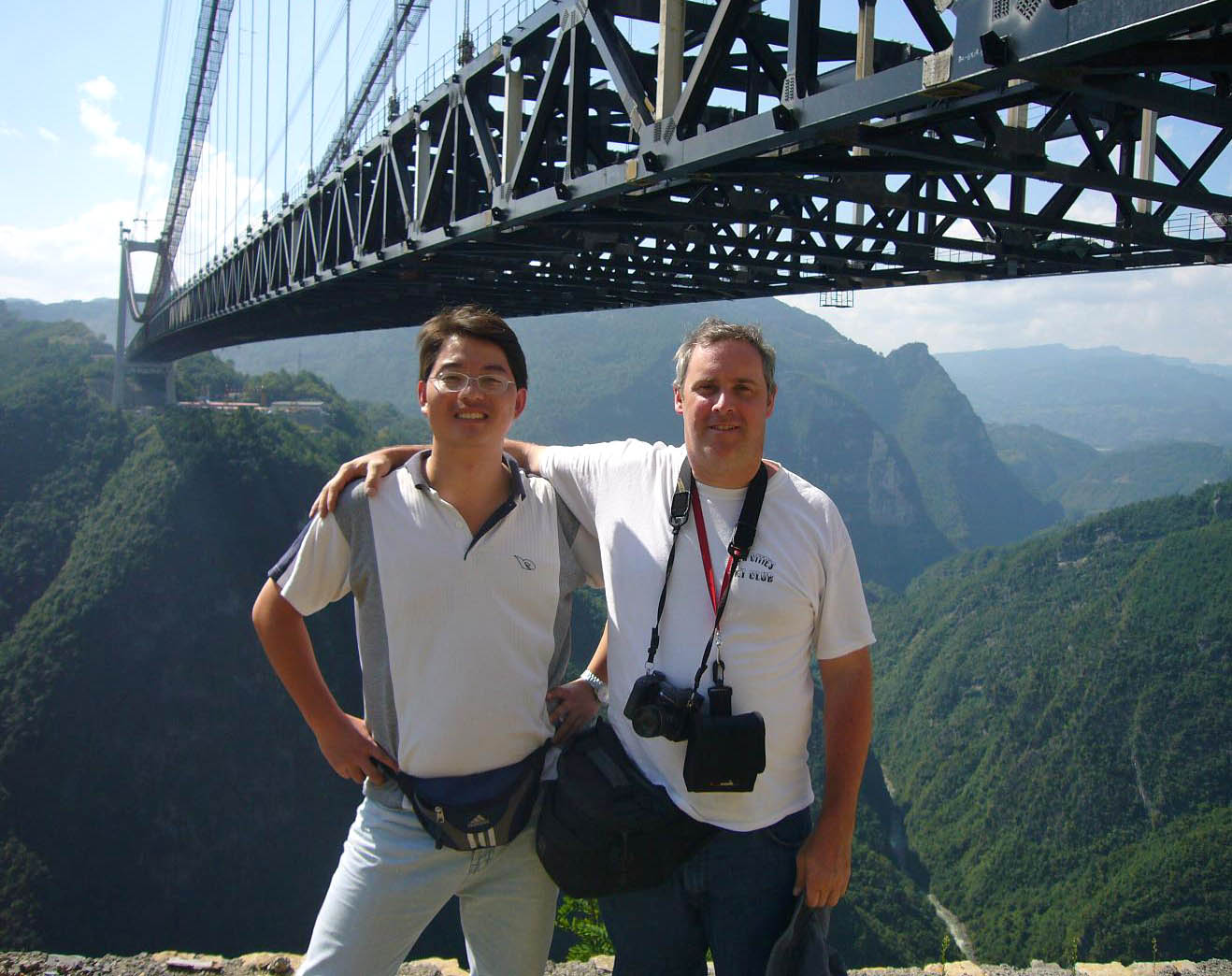Difference between revisions of "China 2018 Trip"
| Line 477: | Line 477: | ||
| − | + | ||
| + | |||
| + | |||
| Line 493: | Line 495: | ||
| + | The two new Dongting Lake Bridges will be completed in 2018 and include an asymmetrical suspension bridge with a main span of 1,480 meters and the largest double span railway cable stayed crossing with a configuration of 406 meters x 2. | ||
| Line 500: | Line 503: | ||
[[File:BadongYangtzeBridge4_copy.jpg|300px|left|thumb|Badong is the most downstream bridge to cross the 3 Gorges reservoir]] | [[File:BadongYangtzeBridge4_copy.jpg|300px|left|thumb|Badong is the most downstream bridge to cross the 3 Gorges reservoir]] | ||
| + | |||
| + | |||
| + | |||
| + | |||
| + | |||
| + | |||
| + | |||
Revision as of 20:12, 24 September 2017
Come Along On Our 6th Annual Bridge Trip To China
July 1 - July 21, 2018
No other river on earth has seen more bridge building activity then China's famous Yangtze River. Between Shanghai in the East and Chongqing City 1,000 miles to the west, more then 70 major spans have been constructed in the last 20 years. Nearly half the world's longest suspension and cable stayed bridges cross or are in the vicinity of the Yangtze including Hutong and Sutong, the world's 2nd longest and largest cable stayed and Chaotianmen and Shibanpo, the world's longest arch and beam bridges. The cities of Wuhan and Chongqing are home to more then 10 Yangtze bridge crossings a piece. Also in the final stages of construction are Yangsigang Bridge, the 2nd longest suspension bridge on earth. The start of the trip will begin at the famous Tiger Leaping Gorge where the highest railway suspension bridge and the longest single tower suspension bridge are under construction along with Jinshajiang Jin'an, the first high level suspension bridge in China to surpass the main span of the Golden Gate Bridge.
With so many large spans unseen to bridge fans outside of China, HighestBridges.com will be undertaking an unprecedented trip to visit all of the major crossings across the entire official length of the Yangtze from the city of Lijiang before the Jinsha Jiang becomes the Yangtze River all the way to the mouth of the Yangtze at Shanghai. But our trip does not end with these 60 spans. In addition, we will also be visiting several of Western China's highest bridge spans along the G42 expressway in Chongqing and a tour of the 3 Gorges Dam, the largest hydro electric structure on earth.
Our 6th annual bridge trip will follow the pattern set with the 2011 High Bridge Trip with a small group of bridge fans meeting in Shanghai before flying to Tiger Leaping Gorge deep in western China where our trip will begin with our personal driver, mini-van and interpreter. This is no chartered bus trip to a scenic overlook for a quick snapshot of each bridge. Our driver will be dropping us off in the center or at one end of each bridge where we will hike across the span on pedestrian walkways or in the safety lane as well as trekking underneath the deck and just about anywhere else we can legally go to get that perfect photo. Expect to smell, touch and feel these bridges in a way you could never do in Europe or the U.S. Prepare for some dust, dirt and a lot of sweat.
While the emphasis of the 2018 trip is very different then the high bridge theme of previous trips that also makes up the contents of this website, these super long spans will be every bit as spectacular and amazing. This 3-week trip will be open to no more then 6 people as we will be traveling in one mini-van or a large SUV. This will be a gathering of adventurous bridge fanatics who don’t mind a journey off the beaten path.
You will visit more than 60 long span bridges on this trip
including 5 of the world's 10 longest suspension bridges,
5 of the world's 10 longest cable stayed bridges,
5 of the world's 10 longest arch bridges,
the world's 2 longest double span suspension bridges,
2 of the world's largest extradosed bridges,
the world's highest railway suspension bridge,
the world's longest beam bridge
and so much more!
The sixth ever HighestBridges.com Organized Bridge Trip to China includes:
• All Ground Transportation via one 6 or 8-seat SUV for 3 full weeks
• 21 Nights of Lodging from Friday Night 8/1 through Friday Night 8/21
• Flight from Shanghai to Tiger Leaping Gorge in Western China.
• Three meals per day plus snacks & drinks
• Visits to at least 10 Yangtze River Bridge construction sites
• Exclusive 2018 Trip Photo Album posted on this website.
• View the 2011 Trip Photo Album at: http://highestbridges.com/wiki/index.php?title=2011_High_Bridge_Trip_Photo_Album
• All for just $4,950!
Bridges of the 2018 China Trip
Wuhan is becoming one of the top bridges cities in the world with at least 8 Yangtze River crossings finished or under construction with 2 more to come by 2015. The latest of these is the record breaking Yangsigang Bridge, the 2nd longest suspension bridge on earth holding up a double level truss with an incredible 10 lanes of traffic.
With towers 194 meters tall and a span of 660 meters, the Tiger Leaping Gorge Railway Bridge has surpassed all other high speed railway suspension bridge crossings in scale.
The west side cable of the Jinshajiang Hutiaoxia Bridge will terminate into a unique mountain anchorage with no tower support.
The trip will be taking us more then 1,500 miles from the upper reaches in Chongqing to the ocean crossings of the Shanghai region. Click in for a closer look!
Closer to Shanghai is Hutong Bridge, the largest cable stayed bridge on earth with a main span of 1,092 meters supporting a giant truss with 6 lanes of traffic and 4 lines of high speed railway. The two main towers will be the second tallest bridge structures on earth at 325 meters.
One of the more famous bridges to rise above the Yangtze is Sutong, the longest cable stayed bridge on earth with a span of 1,088 meters. Less known is the awesome 2 floor museum near the south approach with more models, drawings and photos then you will ever see on the construction of one bridge. The two towers of Sutong are 306 meters high while the total bridge length is 8,206 meters. Construction began in June 2003 and the bridge opened in June 2008. The cost was $1.7 billion dollars.
Just as spectacular and not to be ignored is the nearby Yangluo Bridge and one of the 15 longest suspension bridges on earth. The double X Andrews Cross bracing give it a distinctive look from China's more conventional ladder-type suspension bridge tower braces.
With a span of 600 meters, E'gongyan is not as large as some of China's other suspension bridges but the span was the first of what will eventually be 4 large suspension crossings in the vicinity of Chongqing City. The tower tops have a signature suspension bridge "logo".
The two new Dongting Lake Bridges will be completed in 2018 and include an asymmetrical suspension bridge with a main span of 1,480 meters and the largest double span railway cable stayed crossing with a configuration of 406 meters x 2.
With much of its height "hidden" under the deep Yangtze 3 Gorges reservoir, it is hard to see that the towers of the Badong Yangtze River bridge are 200 meters tall from the top of foundation to the wonderful chrome balls at the top of each tower. Also expect to be wowed by a visit to a couple of new arch bridges just east of the city that are 100 meters high.
Now more then 10 years old, the Baishazhou Bridge was one of the longest cable stayed bridges in the world in 2000 with a main span of 618 meters. The A-frame towers are very similar to Shanghai's Xupu Bridge which it was likely modeled after. The bridge has become a maintenance nightmare since its completion but will hopefully be around for future bridge fans to enjoy.
With the tallest railway bridge pier supports ever at 456 feet, the absolutely monstrous Caijiagou Viaduct is one for the record books. Crossing 2 deep valleys, the 2 track bridge is well over 100 meters high for most of its 2 kilometer length and should be completed by late 2012 when it will open along the first ever high speed line from Chongqing City to Shanghai. All you can say is wow!
With its bright red ribs above the road deck contrasting with lower level concrete supports, the Caiyuanba Bridge makes a striking new addition to Chongqing's ever growing collection of super spans. The central gap of 420 meters is among the 10 longest arch spans on earth. Traveling through the lower level truss is a unique mono rail metro line.
The Chongqing fun continues with a stop at the longest span arch bridge on earth, Chaotianmen. Located just north of the confluence of the Yangtze and Jialing Rivers, this soaring red super span has 6 lanes on the top level with 4 more below that share room with 2 rail lines. The shape of the arch was inspired by the famous Sydney Harbor Bridge which in turn had been inspired by New York's Hell Gate Bridge.
One of the 10 longest span cable stayed spans on earth, the Chongming Island connection to Shanghai is also one of the most beautiful with single towers supporting a rare split roadway box deck that is over 50 meters wide. The towers rise 210 meters above the Yangtze River.
With beautiful blue pin stripes slicing down the center of each white tower, the Fengjie Bridge gives a nice welcome to travelers entering the 3 Gorges region from the west. The main span is 460 meters.
With unpainted towers, the Fuling Bridge proudly shows off its raw concrete A-frame cable stayed towers. Since its construction in 1997, Fuling city has added 4 more major cable stayed spans to its growing collection with a 5th to be completed in late 2012.
Fuling Lidu Bridge is located upstream of the city and was completed in 2007 with a main span of 398 meters. Just when you thought conventional H-frame cable stayed bridge towers went out of fashion in the 1990s!
Guojiao Bridge was completed in 2011 as the first extradosed bridge to be built across the Yangtze with a main span of 248 meters. The wishbone shaped towers make the design an even rarer breed of the extradosed bridge style.
HanTangjiatuo is yet another giant truss stiffened cable stayed bridge that will be completed in 2012 for the new high speed line between Shanghai and Chongqing. The west end terminates into a tunnel.
The arch ribs of Hejiang Bridge were closed in December of 2011. With a span of 500 meters this is the 6th longest arch on earth and the second longest Yangtze River arch after Chaotianmen. The arch design was chosen over more conventional cable stayed and suspension bridges.
Hejiang is another of China's CFST or concrete filled tubular arch bridges in which the thin walled steel tubes sections are light and easily erected before concrete is pumped into them. Once hardened, the concrete solidifies and stiffens the arch, improving the compressive strength of the entire structure.
.
One of the newest spans in the region upstream of Chongqing City is the under construction Jiangjin Yingbing Bridge with beautiful wishbone shaped towers inspired by the 3rd Nanjing Bridge. The truss deck looks to have a rail or metro on the lower level. We will be visiting the bridge during its final stages of construction.
No bridge trip to China would be complete without visiting a rare self anchored suspension bridge. Opened in 2011, the Jiangxinzhou Bridge in Nanjing is one of the largest and most beautiful examples with a single tower supporting an unusual split box girder deck.
Way back in 1999, Jiangyin was the last downstream crossing of the Yangtze as well as the longest span bridge in China. With the completion of the Runyang Bridge in 2005, the Xihoumen Bridge in 2009 and the 4th Nanjing Bridge in 2012, Jiangyin became the fourth largest in China. Today it still ranks among the world's 10 longest with a main span of 1,385 meters or 4,544 feet. The concrete towers are 190 metres tall. The main span is made of flat streamlined steel box girders. The steel deck was erected by raising pre-assembled units weighing up to 500 metric tons with jacks.
The giant Wufengshan Yangtze Railway and Road Bridge will be opening in 2020 as the longest span high speed railway crossing in the world supported by the thickest suspension bridge cables ever spun. The truss depth of 14 meters will also be one for the record books.
Of the two big extradosed bridges we will be visiting, the most spectacular will be the Jiayue Bridge across the Jialing River gorge north of Chongqing City. The unique Y-shaped towers rise from a deck that is already some 90 meters above the river. Completed in 2011, this beautiful highway crossing was designed by the Chongqing office of T.Y. Lin International which also has headquarters in San Francisco.
Completed in 2010, the Jingyue cable stayed bridge is unique in that the main span of 816 meters is supported by towers of uneven height with the taller tower measuring 265 meters and the shorter one measuring 200 meters. This is also the longest span cable stayed bridge in the world with conventional H-frame style towers.
Located in Shashi, a city rarely visited by foreigners, the 500 meter span of Jingzhou Bridge ranks it among the 30 longest cable stayed spans on earth.
The centerpiece of one of the longest sea crossings in the world, the huge blue towers of the Jintang Bridge support a large main span of 620 meters that is once again, longer then any cable stayed span in North or South America. The huge viaduct is one of 3 island hopping bridges that also include Xihoumen, the second longest span suspension bridge on earth.
Built in the grand style of the previous railway bridges at Wuhan and Nanjing, the Jiujiang railway bridge finally opened in 1992 after years of difficulties during its construction.
Luzhou is one of the last major cities on the upper Yangtze to have more then one bridge crossing. Three 170 meter spans make up the concrete beam 2nd Luzhou Bridge crossing.
One of the dozen longest span single tower cable stayed bridge in the world, Luzhou's Taian Bridge crossing carries 2 lanes of local traffic and opened in 2008, the year of the Beijing Olympics.
Ma'anshan Bridge will be nearly completed during our 2012 visit and consists of the 2 longest back to back suspension spans on earth. The concrete section that makes up the lower portion of the central tower is somewhat different then downstream neighbor Taizhou which is made up of an all steel A-frame style support.
Though not as large as the suspension spans, the eastern section of Ma'anshan will be arguably more beautiful with 2 back to back 260 meter cable stayed spans supported by oval shaped support towers that are the first of their kind in the world.
Ma'anshan Bridge engineers spent many long hours calculating the more unusual cable stay forces within the oval shaped tower supports.
Masangxi Bridge is tied with Dafosi as the 3rd Chongqing City cable stayed bridge to be built cross the Yangtze.
The punchy red colors of the Meixihe arch bridge made it my choice for the photo you see on the main page of HighestBridges.com. The rising waters of the 3 Gorges reservoir made it necessary to build the nearly 1,000 foot arch span. Just upstream of the arch is the giant Meixihe cable stayed bridge that carries the G42 expressway along the North side of the Yangtze River and the 3 Gorges region.
While Minpu might only rank 10th longest among the world's cable stayed spans, this Shanghai monster is the world's largest double decker cable stayed bridge with a massive truss that carries 6 lanes on top and 4 on the bottom. Could it be the world's heaviest cable stayed bridge span?
Nearby single tower road and rail Minpu 2 Bridge also deserves some respect when it comes to size with a double decker main span of 251 meters.
For many decades the Nanjing Yangtze River Bridge was China’s most famous crossing. It was completed in 1968 and is the first double-decker, double-track highway and railway bridge designed and constructed by the Chinese without outside engineering assistance.
After the withdrawal of Soviet experts following the Sino-Soviet Split, the project was undertaken to prove that Chinese engineers were able to take on a project of this size on their own. There is also a bus stop and a museum. The bridge is 6,772 meters long and has a span of 160 meters.
The central river crossing section of Nanjing spans 1,577 meters with the bridge approaches measuring another 3,012 meters. The upper deck of the bridge is a highway with a length of 4,589 meters. There are sidewalks on either side of the highway and each measures over two meters in width. The lower deck holds a twin-track railway with a length of 6,772 meters and a width of 14 meters that allows two trains to run in different directions.
With just one crossing for over 3 decades, the city of Nanjing finally built a 2nd crossing in 2001 in the form of a huge cable stayed bridge with a main span of 628 meters.
Just 20 meters longer then the 2nd Nanjing Bridge, the 3rd Nanjing crossing became an instant Nanjing icon in 2005 with steel towers that continuously curve as they rise 705 feet above the Yangtze River.
With deck lifting underway in late 2011, the 4th Nanjing suspension bridge is well on its way to becoming the 6th longest suspension bridge on earth when it opens in mid-2012. Despite ranking 3rd in span length in China behind Xihoumen and Runyang South, the Nanjing 4 has two completely suspended side spans giving it the longest continuous section of suspended bridge deck on a single span suspension bridge in China. The curving cross brace on each of the 225 meter high towers will make the bridge more distinctive then China's other super long suspension spans.
The Nanqi Changjiang suspension bridge will far and away become the longest span bridge along the upper half of the Yangtze when it opens in late 2012. Even downstream neighbor Chongqing City does not have any bridges with a span as long as Nanqi.
Pengxihe is another "cable stayed bridge on stilts" with the taller of the two towers measuring a lofty 663 feet.
Despite its ranking as the 4th longest suspension span on earth, Runyang Bridge is easily the least known of the world's 10 longest spans so maybe this mention will add a little more to its notoriety. The suspension component of Runyang is just one portion of the entire crossing which measures a jaw-dropping 22 miles from end to end. The north bridge is a cable-stayed structure with a main span of 406 meters supported by towers 150 meters tall. In between the two bridges is the island of Siyezhou where we will be staying at a 4-star hotel overlooking both spans. The suspension deck is a streamlined orthotropic steel box girder that is 3 meters deep. The width of the deck is 39 meters, accommodating 6 traffic lanes and a narrow walkway. The height clearance for river navigation is about 50 meters.
The highest bridge of the entire trip will be the new Shennongxi cable stayed bridge that crosses 200 meters above the deep waters of the 3 Gorges reservoir. Once completed in mid-2012, the Shennongxi Bridge and the G42 expressway will finally allow motorists to go non-stop on a high speed expressway from Shanghai to Western China along the north side of the Yangtze River.
The most popular type of bridge on earth is the beam. As common as they are with millions of examples around the world, none is as large as Chongqing City's record breaking Shibanpo Bridge. Opened in 2006 and designed by T.Y. Lin International, the main span of 330 meters consists of a 103 meter central steel box girder suspended between two concrete arms.
The steel box element was incorporated into the design to significantly reduce the bending moment and shear of the structure and make such a long span beam structure technically and economically efficient. This steel box section was fabricated in Wuchang, a city about 1,000 km downstream of Chongqing on the Yangtze River. The fabricated steel box section was closed on both ends with steel noses, launched as a barge and towed upstream by tug boats. Along its journey, it went through the locks of the Three Gorge Dam. On May 27, 2006, after it arrived at the site, the steel section was turned 90 degrees using cables anchored at both banks of the river. Then the 1,400-ton, 103 meter long box girder was lifted successfully from the Yangtze River to its final place with strand jacks.
While Taizhou Bridge broke the record books in 2011 as the longest double span suspension bridge, this mighty crossing of the Yangtze also broke cable length records with two of the longest bundles of wire ever spun from anchorage to anchorage with a cable length exceeded only by Japan's Akashi-Kaikyo Bridge.
The central tower of Taizhou is made entirely of steel with an A-frame tower support that is quite different then upstream neighbor Ma'anshan which has a single support made of concrete. Both spans share the world record with back to back spans of 1,080 meters.
The 4-lane G42 highway glides almost 200 meters above the reservoir filled Tangixhe canyon on a monster-sized span of 755 feet that is held aloft by the 15th highest bridge piers in the world at 156 meters. The bridge deck may be as high as 200 meters if measured to the old level of the Tangxi River.
Yet another entry among the world's top 20 cable stayed spans, Taoyaomen connects two ocean islands separated by a very deep channel within the Zhoushan Island Archipelago with a giant span of 580 meters.
Tianxingzhou broke records in 2009 when it became the longest combination road and rail cable stayed bridge in the world with a span of 504 meters. That record was broken again in 2012 when downstream neighbor Anqing opened an even bigger road and rail span of 580 meters which in turn will be surpassed by another Yangtze crossing at Tongling with a span of 630 meters in 2014. Tianxingzhou is one of a collection of what will soon be 10 Yangtze River crossings in the vicinity of Wuhan.
While the world waits for Tongling to complete their record breaking road and rail bridge, we can currently enjoy a visit to their 1995 cable stayed crossing of the Yangtze
Wanxian was one of China's first bridges to enter the record books, in this case for longest concrete arch. Completed in 1995 the arch spans over 420 meters above the deep waters of the 3 Gorges reservoir. During construction, a concrete-filled tubular arch truss frame was built to support the weight of the concrete arch and is embedded within the arch. The span displaced the previous record holder, Croatia's Krk Island Bridge. China is now working on an even larger concrete arch for a rail line in Guizhou Province.
Just downstream of the giant Wanxian arch is the more conventional but no less beautiful Wanzhou No. 2 suspension bridge which was completed in 2004 to give Wanzhou residents a crossing of the Yangtze on the north side of the city.
The second of Wuhan's soon to be 10 Yangtze crossings, the appropriately named Wuhan 2nd Crossing Bridge came in 1995 - almost 40 years after the famous 1957 road and rail bridge was completed.
Also known as Wuhan Bridge No. 4, the Wuhan Junshan cable stayed bridge carries the G4 outer ring road around the southern end of Wuhan City with a span of 460 meters. The bridge became 10 years old in 2011.
One of China's early road and rail bridges from 2000, the Wuhu cable stayed bridge has a main span of 312 meters or just about half the central span of the now under construction road and rail bridge in nearby Tongling. As with all of these hybrids, the concrete cable stay towers are considerably bulkier then their road-only counterparts.
Wujiang's arch became one of the first bridges in China to be built by the rotation method where the two halves of the arch are constructed just above the ground on either hillside and then rotated out over the canyon in one careful maneuver and then closed at the crown.
Fuling's 6th and final cable stayed bridge will cross the Wujiang just upstream from the famous arch. The new highway skirts along the east side of the Yangtze and will open in late 2012. The span length is unknown but will likely be in the 500 meter range. The deck will be at least 100 meters over the 3 Gorges reservoir that flooded the mouth of the Wujiang River just north of Fuling City.
The Wushan Yangtze River bridge is one of the 10 longest arch spans on earth and is arguably one of China's most beautiful with the surrounding mountains of the 3 Gorges rising thousands of feet above the river valley. A half through arch, Wushan ranks 7th among the world’s longest span arch bridges. The main arch was constructed using the stayed cantilever method whereby a tower is erected on either side of the gorge and cables temporarily radiate out from it to support individual sections of the arch until the two halves can be joined in the middle. A cable high line between the tops of the two towers was used to move the steel sections into place high above the river. Once the arch was closed, concrete was pumped into the 8 main ribs of the arch span, stiffening and strengthening the entire structure.
Xihoumen Bridge is the second-longest suspension bridge in the world as ranked by the length of the center span. The 5.3-kilometre-long suspension bridge has a 2.6-kilometre-long main bridge with a central span of 1,650 metres. The approaches total 2.7 kilometres with a road width of 24.5 m.
For stiffening there is a rare double-box girder with a middle opening of 6 meters. The adopted deck is an orthotropic plate with ventilation in the middle composed of alternating closed box diaphragms 3.5 meters deep. On the south end of the bridge there is an awesome museum on the construction of the entire Zhoushan Island Bridge project with giant models, drawings and displays on the construction of Xihoumen, Jintang and Taoyaomen Bridges.
The new G42 crossing of the Daninghe is one of the 12 longest arches ever built with a span of 400 meters. The new steel arch is both a physical and spiritual replacement for the Dragon’s Gate bridge that once spanned the mouth of the Daning River before the rising waters of the 3 Gorges reservoir forced its removal. The concrete arch gateway marked the starting point for millions of tourists on their boating adventure up the most spectacular tributary of the entire Yangtze River 3 Gorges region - the Daninghe. Known as the Lesser Three Gorges to differentiate it from the Yangtze River, a trek up the Daninghe reveals more than just one of China’s largest arch bridges. The initial Dragon Gate gorge has many wonders beginning with the longest plank walkway in China. Further along is Misty Gorge with beautifully sculptured stalactites tagged with colorful names like Monkey Fishing in the Air and Fairy Peach Peak. Continuing into the final Emerald Gorge, boats pass such landmarks as the Sky-Scraping Red Wall and Flying Clouds Cave.
Xiling Bridge is located just a few kilometers downstream from the Three Gorges Dam and is not open to the public to drive across without permission. Completed in 1996, the 18 meter wide bridge has a tower to tower span of 900 meters and was built largely to assist in the construction of the monstrous dam.
Although no longer among the world's top 10, Yangpu Bridge was once-upon-a-time the longest cable stayed bridge in the world with a main span of 602 meters. The deck is 30 meters wide with six lanes of traffic that glide almost 50 meters above the Huangpu River. Originally unpainted, the towers were coated red for the millennium. The name Yangpu Bridge (杨浦大桥) is inscribed on each pylon based on original hand writing by Deng Xiaoping.
Yichang Bridge is typical of most of China's big suspension bridges with unsuspended side spans and concrete towers. The tower to tower length of 960 meters is long enough to rank it among the world's 25 longest suspension bridges. Both the towers and deck stand out with their all red paint scheme.
The new Yichang Yangtze Railway Bridge has the 2 longest railway beam bridge spans in the world at 275 meters apiece albeit with the assistance of two tied arches.
Yiling Bridge is the only crossing of the Yangtze River located directly across from the city of Yichang. At the time of its construction in 2001, Yiling was one of the world's longest 3-tower cable stayed bridges with two central spans of 346 meters.
Yingwuzhou is Wuhan's latest crossing of the Yangtze with two back to back spans of 850 meters - equivalent to the 2 Tacoma Narrows Bridge spans placed end to end. This will be Wuhan's 8th crossing of the Yangtze with a 9th and 10th crossing to begin construction in 2012. Yingwuzhou's catwalks should be complete during our visit. The name translates to Parrot Chou Bridge.
While construction will not begin until 2012, it was too tempting to show everyone the first drawing of Wuhan's next monster - the Yangsigang Bridge. Announced in late 2011, this crossing of 1,700 meters was originally planned to be a suspension/cable stayed hybrid. Instead the engineers reworked the design into what is now going to become the longest span double decker bridge ever and the 2nd longest span on earth. The giant truss will have 6 high speed lanes on top and 6 lanes below for slower, local traffic.
Lijiatuo Bridge has the distinction of being the first Chongqing City cable stayed bridge to be built across the Yangtze "way back" in 1995.
Yunyang is a rare cable stayed bridge with asymmetrical towers. The taller tower is 85 feet higher above the Yangtze River. Like many other big bridges that are over the 3 Gorges reservoir, Yunyang's deck height of 104 meters is now only half visible with the water level having been raised 75 meters over the old level of the Yangtze River. Yunyang means "clouded sun" which is probably a good description of the weather that often hangs over the region.
The latest Chongqing City regional suspension bridge is Yuzui, located on the northeast side of the city to facilitate easy access to the huge new city airport. The main span measures 616 meters with a 100 foot wide deck that carries 6 lanes of traffic plus 2 safety lanes. The span is composed of 50 steel box girder sections that are 12 meters long with each weighing 180 tons.
Far less known then its counterparts in Nanjing and Wuhan, the Zhicheng crossing of the Yangtze is another huge road and rail behemoth with 9 spans of 160 meters.
Zhongxian Yangtze Bridge is the longest of all the upper Yangtze crossings with a length of 2,129 meters composed of an assortment of spans that are as follows: 35X3+40X3+112+200+112+205+460+205+40X4+30X15. The bridge is half submerged in the deep waters of the 3 Gorges reservoir and carries the western end of the G50 expressway across the Yangtze River.
The newest bridge to be under construction on the trip will likely be the new Chongqing metro line crossing of the Jialing and Yangtze Rivers which necessitated the construction of two separate cable stayed bridges known as Dongshuimen and Qianximen that are separated by a long tunnel. The towers were carefully designed by T.Y. Lin International to have a curvilinear shape in all directions that will give them a beautiful, signature look that has also added considerably to the cost. The orange color scheme may well divert attention away from nearby Chaotianmen arch bridge. Chongqing City is quickly becoming the Pittsburgh of China with what may well become the greatest collection of large scale bridges to be located in one city.
A total of 4 to 6 people will be on the trip plus myself and one or two drivers. As trip planners and organizers, we will be taking care of everything for the 4 to 6 additional guests. This includes the round trip air fare from Shanghai to Western China as well as the hotels, meals and car travel. We hope to pair single people together in hotel rooms but if you don’t mind the additional cost you can have your own private room for the duration of the trip. With each spot being filled on a first-come, first-served basis, you might be out of luck if you wait too long!
This trip is not for the timid or physically challenged. We will be traveling down into the canyons beneath these bridges on dirt roads that will be bumpy, dusty and uncomfortable. There will be short but occasionally strenuous hikes down paths to reach spectacular viewpoints. At the end of the day you will be sweaty, dirty and wanting nothing more than a hot meal, a hot shower and a cool hotel room to sleep in.
Feel free to contact me with any questions you may have at Eric@HighestBridges.com. The price of this 3-week trip is 3,950 dollars which is an incredible bargain, so don't be shy about contacting me. This trip can only happen if at least 4 people sign up!
A List of many of the 60 Yangtze River Bridges on the Tour can be seen at the link below
http://en.wikipedia.org/wiki/Yangtze_River_bridges_and_tunnels
Looking To Create Your Own Western China Bridge Trip?
Regardless of whether you want to be a part of my bridge tour or head off to Western China on your own, you need to understand up front that you cannot drive to these bridges yourself. Since you must hire your own guide and/or driver, the following travel advice is for anyone who might be thinking about planning their own bridge trip through China. Much of this advice also applies to those who might be coming on my 2012 trip.
With so many spectacular, long span bridges in one region of the world, many will be wanting to hop on the next plane to China and begin a whirlwind tour of these record breaking spans. Before you run out and buy a ticket, there are some very informative suggestions you need to learn about. These are not just tips but very important warnings that can make the difference between a once in a lifetime experience or an unforgettable nightmare.
A visit to the rural mountains of Western China is a world apart from a trip to a modern city like Shanghai, Beijing or Hong Kong. The big city hotels and western style restaurants that cater to English speaking tourists are not to be found in Western China outside of a handful of large cities. Many of the big bridges located within this web site are far away from these big cities in mountainous regions of mostly poor farmers, many who have never seen a foreigner. This means that you will have to be resourceful and adapt to a rough environment that is more like a third world country where access to reliable transportation, food and lodging cannot be taken for granted.
First, do not even think of driving or renting a car in China’s western provinces. You can only visit these bridges by hiring a taxi driver for every day you are there. The mountain roads are incredibly dangerous, requiring an experienced driver to dodge any and every imaginable form of human and animal life as well as reckless trucks, automobiles and motorcycles. These assaults will come at you from every direction. When you are on these secondary roads, your driver is going to be using his horn constantly. Driving-by-horn in the mountains is not just an option but an important survival tool. To avoid colliding with people, bicycles and animals, a constant “beep” is required to warn each and every one of them. For a taxi driver, the use of a horn is second nature - for you it is not. Much of the time you will be on unpaved dirt roads filled with potholes, rocks and mud. Trucks and buses coming in the opposite direction are going to pass slower traffic by coming head on into your lane, forcing you to come to a sudden stop. If you did get in a collision, in a very real sense, you would be at fault even though the other driver came into your lane! Other times you will be stuck behind a slow moving truck, trapped in a cloud of dust and exhaust thicker than a dense fog.
Hired drivers and taxis are good because they know their regions well, they know what roads might be under construction or are washed out, what roads are dangerous and what roads are safe. Outside of the major highways, maps have little or no detail and only Chinese names. The rural sign-age you encounter on local roads will also be in Chinese language if there is even a sign at all.
But even if you could convince a Chinese car rental company to rent you a car and even if you could read Chinese road signs, and even if you could learn to use the horn and dodge oncoming traffic, the most important reason to hire a driver relates to the bridges themselves. You are there to walk across and under the bridges to take photos and experience the scenery. Many of these bridges do not have safe areas to pull over and park. In some cases, your driver will have to drop you off and park further down the highway and wait for you. In other cases you will want him to take you down to the bottom of the bridge on some unknown side road. A personal driver means having no worries about leaving your car on the side of the road with your belongings left unattended. It means no worries about getting lost, and best of all, no worries about getting in an accident. There is also no cost difference. For a little over a $125, you will have your own personal car and driver for the entire day. No insurance papers or damage waivers to fill out, no unforeseen tows or car repairs, no expensive late fees.
Finally, the best reason you might want a driver is food. When you are up in the mountains, you will not be able to stop off at a Denny’s or a McDonalds. The driver will know what places to avoid. He will not shy away from going into the back of the restaurant to check on the quality and trustworthiness of the meat you will be eating and how it will be prepared.
Now that I have convinced you that hiring a driver is the only way to go, you need to be warned that many drivers cannot be trusted and you will have to pick a driver that can be counted on to serve you and not try to steal or rip you off. If you don’t watch out you could find yourself sitting on the side of some mountain road, your taxi driver having taken off with your belongings, never to be see again.
Due to the long distances between these bridges, there might be days you are going to have to bring all of your luggage with you as your one or two day taxi driver is going to be dropping you off in a different city from the city where you hired him in the morning. That means you will have to entrust your belongings with him as you visit the different bridges. As an outsider in these regions, you are going to stick out like a sore thumb. People might want to take advantage of you if you let them.
If you do not have the money to have a travel agent set you up with your own driver for the entire trip then the best person to find you a good taxi driver each day will be the concierge at the hotel you are staying at. They will have a known pool of drivers that they use and the drivers will be less likely to try anything funny. Even so, a driver knows you are unfamiliar with negotiating and so the price you agree on should be clear and well established before you leave. You should expect to pay him extra if the day extends to 14 hours instead of 12 as you had planned or if you drove 600 miles (966 km) instead of 500 (805 km). All of this should be worked out in advance. You should expect to pay him in cash when you get back to your hotel in the evening. If you have to stay overnight away from his city, you will need to pay for his hotel room. You should also expect to pay for his lunch. It is an inexpensive courtesy that may earn you some points if you get back a little late or want him to do something risky like illegally pulling over in the middle of a bridge, etc. And if you had a great day, why not invite him to dinner when you get back to the hotel. I got along with my driver so well in Guiyang, he agreed to come back the next morning and spend two hours showing me another high bridge I had not know of - for free! When you get into the taxi, always snap a digital photo of his license which should be on the dashboard.
The most important thing you can try to bring with you on a vacation to Western China is another person, whether it be your own spouse, a close friend or a hired Chinese guide. He or she can be a second set of eyes as well as someone who can go along with you when you venture down into some unknown gorge to take photos. I visited many of China’s high bridges with an English speaking Chinese engineering student from Shanghai who handled all of the dealings with the taxis and hotels. He made sure every driver was an honest one as well as telling the driver what will be in store for them. Many of these small taxis have low clearances that are unsuitable for such horrible roads and a driver might not want to head into the mountains to have his car get abused for the same money he can make in the city on normal roads. Communicating your desire to go “off-road” is crucial to finding a good match for a driver. Finally, do not ever agree to go along with a taxi driver who wants to “bring his friend along” for the day. Two guys taking you into the mountains or down a back alley could easily be a setup for a rip-off.
Once a good driver is found, your biggest hurdle will be communication. The driver will not know English or any other language outside of Chinese, so you will need to be prepared. Prior to leaving for China, you should print out a full size image of every bridge you plan to visit along with the Chinese and English names also printed on the photo. In addition, be sure to print out any maps from this web site with the location and names of the bridges you want to visit as well as purchasing a China Road Atlas that is available at most airports and bookstores. Also good for planning your entire trip is a fold out map like the ones sold by Nelles that cover the general regions of Central and Southern China. People are very un-knowledgeable about bridges. They don’t know the difference between a suspension or a cable stayed bridge. Photos, names and map locations of each bridge will be your only way to show the driver exactly what bridge you want to visit and its general location. Even so, expect to be frustrated as you will get lost from time to time - ultimately the driver is not likely to know these rural back roads any better than you will. Asking locals for directions will often be your only guide.
Outside of the concierges in the nicer 4 or 5 star hotels in the cities of Chongqing, Guiyang and Kunming, people in the western provinces do not speak English or any other foreign language. There are few hotels in most of the smaller cities and towns in the mountains. For those visiting the West Hurong highway, the cities to stay in are Enshi and Yesanguanzhen. Along the Yangtze River, most of the larger cities have hotels that cater to tourists. You should always plan on getting back to a hotel by the end of the day. Driving at night is generally not safe except on the major highways and in the cities. You can read more at http://wikitravel.org/en/Driving_in_China. Be sure to scroll down to the section titled “Danger”. Remember, for every mile a person travels on a road in China, the likelihood of getting killed is the same as driving 10 miles in Europe or the U.S.
Now that I’ve covered the nasty side of travel on China’s tough roads, I will go over the easy side of travel - the planes, trains and buses. Unlike most countries in the world where you must buy plane tickets in advance, China’s airports are more like bus terminals where you can sometimes purchase a ticket just a few hours before a flight. Even so, large discounts can be had on the web if you book a ticket on line at least a day in advance. All of the airlines can be compared and purchased on http://english.ctrip.com/. This makes it a perfect way to travel between a larger city like Chongqing or Guiyang with some of the smaller cities like Yichang or Wanxian. Instead of spending 5 hours in a bus you can hop between two cities in just an hour.
Buses may be slower than planes but they are the only form of transportation outside of a taxi that can take you to some of the smaller cities and towns that are in the mountains. In addition to easy accessibility, they also tend to run more frequently than planes and trains and are quite comfortable.
Trains are not any quicker than a bus or a taxi but they are incredibly cheap in China and allow you to catch up on sleep or take in the countryside. Train tickets are generally divided into separate classes. The hard and soft seat are the cheapest and most common way to travel but they are often crowded and uncomfortable for long routes. The best is the soft sleeper with only 4 beds to a room and not much more than a hard sleeper where there are 6 beds to a room. Getting a ticket is the most difficult aspect of train travel. Large stations are often crowded and travel during holiday periods should be avoided. You don’t have to worry about eating as all trains have roving trollies and a dining car where cooks can prepare hot Chinese meals. You might want to prepare for the toilets though as they can be dirty and stinky and require you to squat over a hole in the floor, keeping your balance as you try to aim. Finally, expect to bring your own toilet paper - train bathrooms will never have any.
So if you use some common sense and plan out your route carefully, you can have a bridge adventure you will never forget. Just remember that sudden setbacks will come up. Bad weather can come at anytime. Cars, buses and trains break down. Also remember that the advice I have given to you is no substitute for all of the normal, travel related things that you would have to prepare for on any big trip to China that are mentioned in such guidebooks as Lonely Planet or Fodors. The process of obtaining travel insurance, visas, permits and vaccinations are all well described in these books and beyond the scope of this website. Since I have traveled to western China several times, I do have some good contacts with drivers who have visited some of these high bridges and are trustworthy. If you are planning a bridge trip to western China, I will be glad to give you any advice and suggestions. You can reach me at eric@highestbridges.com



